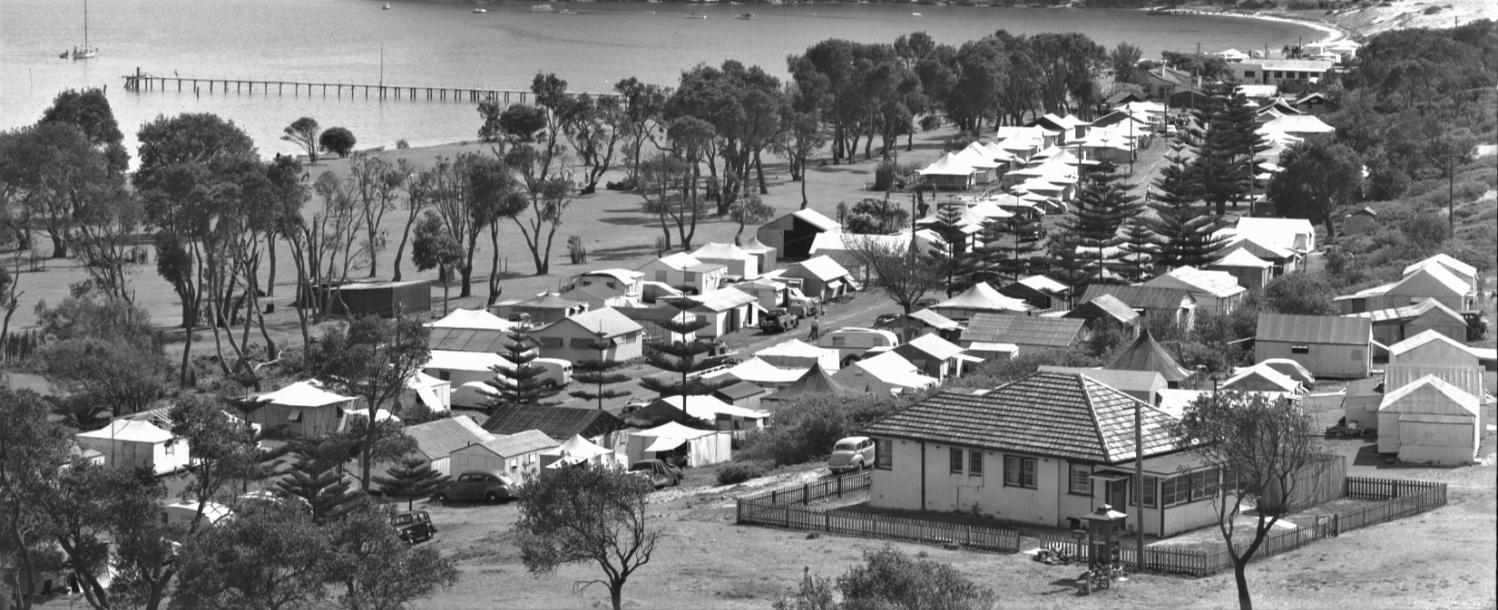September 19 - October 2, 2021: Issue 511
Camping At Palm Beach
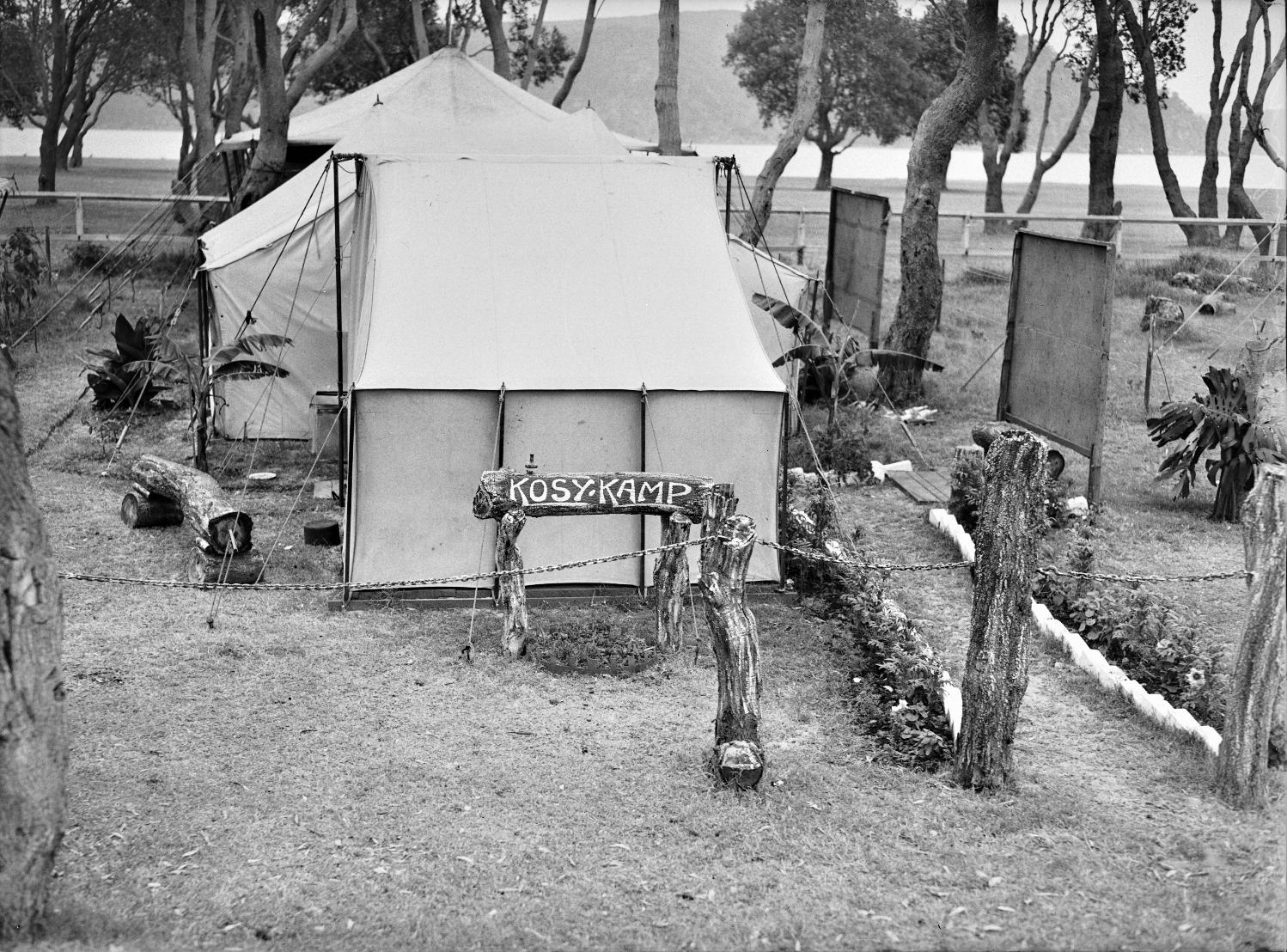
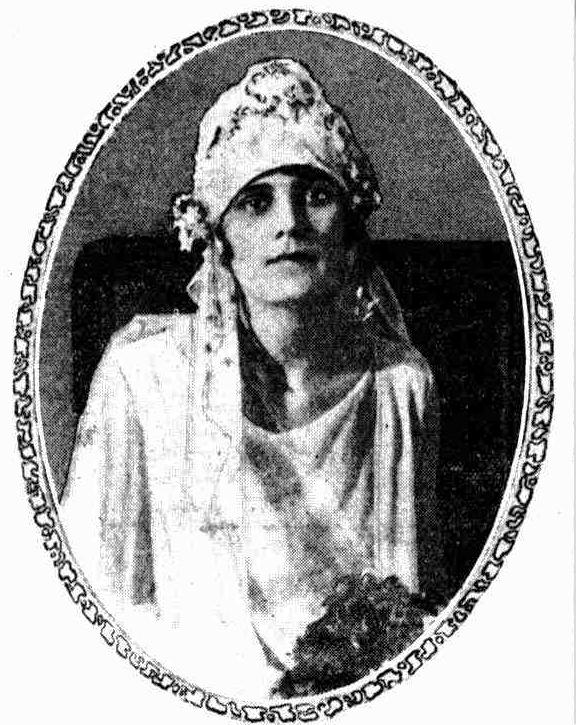
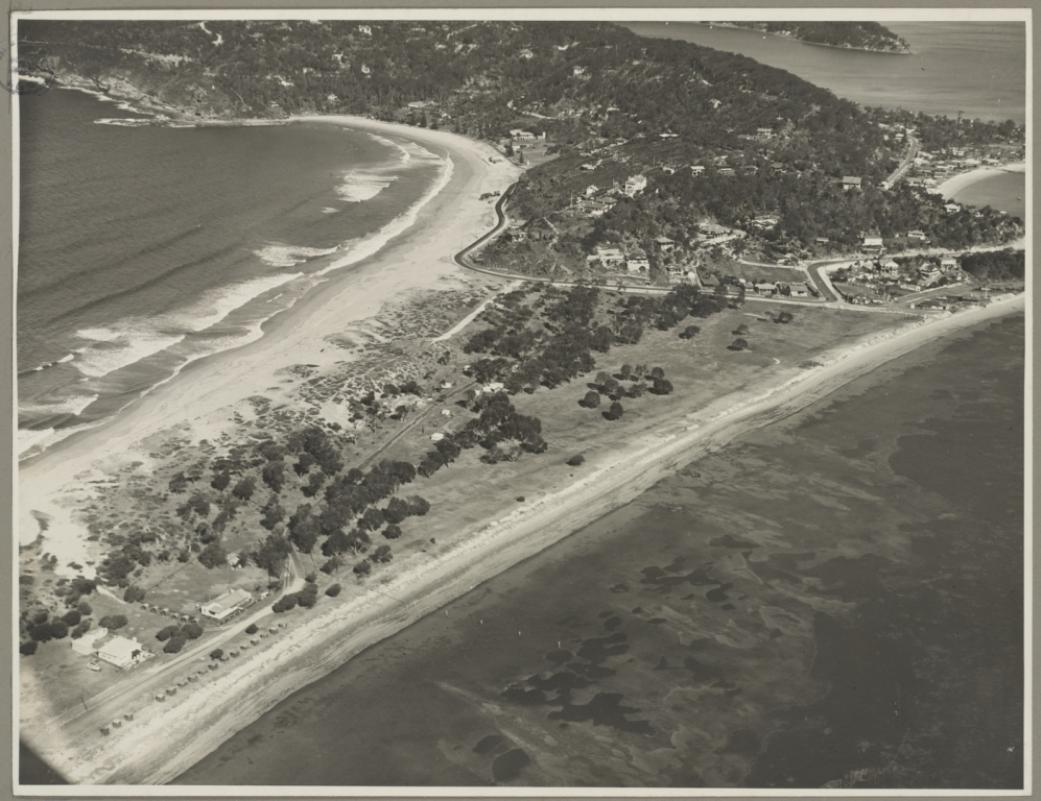
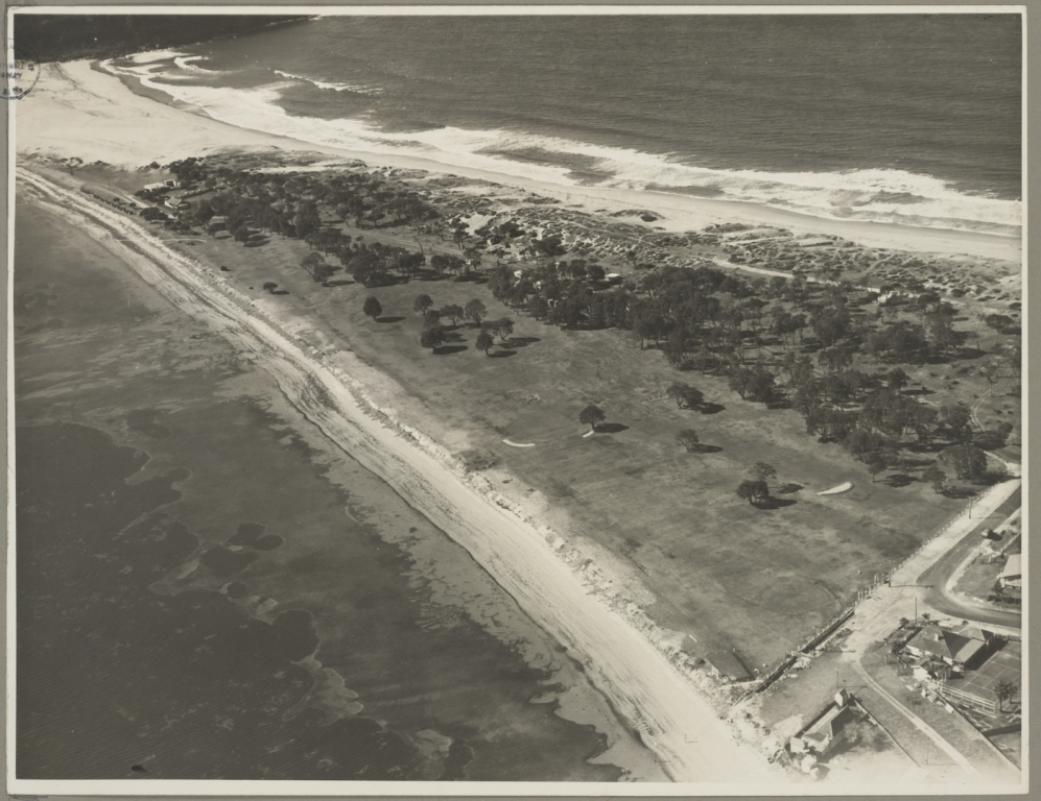
Picturesque By-Paths
On the Way to Palm Beach
With the great improvement in cars and the gradual betterment of road surfaces there is a tendency to drive 'rigid there and home again, no matter what interesting scenery is passed by the way. An instance is the popular run to Palm Beach, which opens up more picturesque views than any other motor road in Australia.
ON the run from Manly to Deewhy there is nothing to see, unless the main road is left at Brookvale and the branch road to French's Forest taken to Beacon Hill, the upstanding point on the right as you reach the hilltop. From this rocky eyrie there is a panoramic view that is like that, from BuIIi Pass. To the south lie Sydney Harbour -at South Head; along the western stretch the lagoons and beaches north of Manly lie outstreatched like a map; north-east is Deewhy Lagoon; and in the north may be seen some parts of Pittwater, and, nearer, Narrabeen Lagoon. So that as far as extensive a view goes Beacon Hill surpasses Bulli Pass.
The main road may be regained by a bush track with good surface which winds down the hillside and then joins up with the Pittwater road at South Creek road, Deewhy. before returning to the main road those who appreciate a secluded nook for lunch or morning tea should take a rough hush track for half a mile near the end of South Creek road, which will bring them to the upper reaches of the South Creek of Narrabeen Lagoon. This is a delightful stream for a swim, safe from sharks. The banks are grass, tree-shaded or sunny as you choose. An old bush track follows the creek down loan early farm-home, quite good for ears, and makes it possible to reach the upper end of Narrabeen Lake by car.
The return to Pittwater road must be made at Deewhy again, and if the car is a surpassingly good hill-climber another magnificent panoramic view may he obtained from the top of the cliffs behind Collaroy. The road goes straight up the cliff-side, and most cars will get at least two-thirds of the way, which means little trouble to reach the top. Along the cliff-side a track runs north, with a most entrancing view of the coastline from Long Reef north to Bungan Headland, below on the right hand. Before descending again the whole of Narrabeen Lagoon may be seen, sun-flecked and serene on even blustery days. Those who have once visited these heights of Narrabeen will want their friends to see what so many motorists have missed by racing along the main road, instead of diverging on chance of seeing something new. It is a big climb on foot, but well worth the. effort, and by car the ascent. is a trifle.
AFTER crossing Narrabeen Bridge a new road runs to the west to Deep Greek, another pretty bit of water scenery, different from anything round Sydney — a clear, cool stream, banked on one side by unusually level meadows, and overshadowed on the other side by towering cliffs, almost impregnable in their roughness and thick growth of vegetation. No more delightful picnicking spot could be imagined than at the foot of the falls halfway up the creek. The motor road stops at a grassy camping ground beloved of the Boy Scouts at holiday time. Instead of returning to the main road, about halfway back there is a new road, built by a private estate, which winds round and over the hillsides till it comes out on the road which joins the Pymble road and Narrabeen.
By far the best approach to Mona Vale is by way of this Pymble road, joining it at the tea-house on the heights. At Mona Vale the Bay view road should be taken past Church Point, around that corner, and along McCarr's Creek to the end. Many week-end motorists know this road goes past Church Point, all though it is well-made. At the road end are boatsheds. From here one of the prettiest boating trips imaginable may be made to the top of McCarrs Creek, where it runs into Kuring-gai Chase. Here is tropical foliage in its Virgin state; great overhanging gums and palm trees, immense ferns, and creepers of hawser-like thickness intertwining their branches.
At Newport there is that wonderful seascape from the lop of Bushrangers' Hill, again missed by most, motorists, yet easily rewarding the slight effort and time taken to reach the top. The. road out to Bungan headland here far surpasses in scenery anything seen so far at close hand from the car, but few diverge from the main road to see its wonderful sea views.
At Newport village, King - street, leads out to Saltpan along a fairly good, track, which opens out views of Pittwater, ana will eventually run round the waterfront to Clareville Beach and be one of the most popular parts of the run to Palm Beach.
NOW, one must return to Newport and pass on to Avalon before Clareville Beach may be reached, but no one with an eye for beautiful surroundings should miss this branch-off — Clareville Beach, with its shady gums over grassy lawns right on the whitest of sandy beaches, crescent shaped, and edged by the clearest, of salt water. It is an ideal holiday camping spot, and a haven of delight for the kiddies. There is a good road out to Careel Bay and along its southern shore, which branches off the Clareville road just as it reaches the ridge above the beach. This makes a lovely motor run for a mile or two through the trees, with glimpses of Pittwater on the left.
Everyone has heard of the Basin, but how few have bothered to take the short water journey across from Palm Beach to see this wonder place for yachtsmen! All you have read about in fairy books is here. And yachting men, above all, know bow to use a place, and leave it unspoiled. Many motorists, unfortunately, have no thoughtfulness for those who are coming after them at camping spots. Such heedless folk should see the Basin as it is after half a hundred yachting, men have used it at Christmas and New Year time.
C. S. HARNETT.
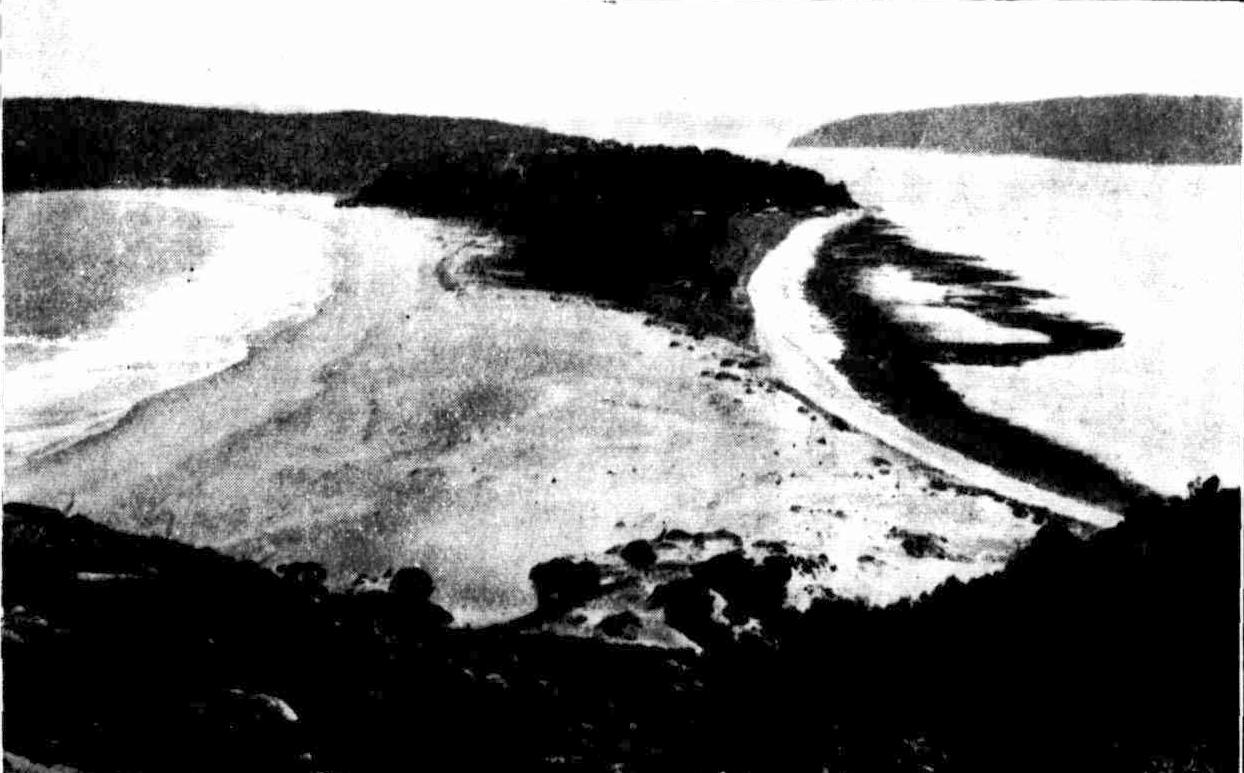
VIEW FROM BARRENJOEY LIGHTHOUSE. From this point a superb panorama presents itself. On the left is the northern part of beautiful Palm Beach, and on the right is a view of Pittwater. Picturesque By-Paths (1926, December 8). Sydney Mail (NSW : 1912 - 1938), p. 55. Retrieved fromhttp://nla.gov.au/nla.news-article166521695
During the Great Depression (1929 to 1939) many Australians to move towards the coast where they could set up semi-permanent dwellings and camp while fishing to provide food for their families and also provide themselves with an income from the extra fish sold. The reserve at Palm Beach we today call Governor Philip park was one of these places people moved to and stayed.
This commenced as people on day outings, in earlier instances, simply installing a bit of shade alike the shade shelters we see today:
AT PALM BEACH.
During recent weeks motorists visiting Palm Beach have been discouraged by the local police from stretching shade awnings over their cars, apparently without any valid reason. It appears that the local municipal authorities requested the police to prevent camping on the beach frontage, and to restrain any motor party from occupying more than reasonable space during traffic crushes. The local council, it appears, does not desire to have the restrictions apply rigidly In every circumstance) or to harass motorists when plenty of space is available. Car owners have complained to the N.R.M.A., that even when parking space was abundant they were prevented from spreading their canvas shelters, and many of them went elsewhere for their outings. AT PALM BEACH. (1929, February 5). The Sydney Morning Herald (NSW : 1842 - 1954), p. 7. Retrieved fromhttp://nla.gov.au/nla.news-article16528805
Some camped wherever they could find a spot of green, both at south and north Palm Beach:
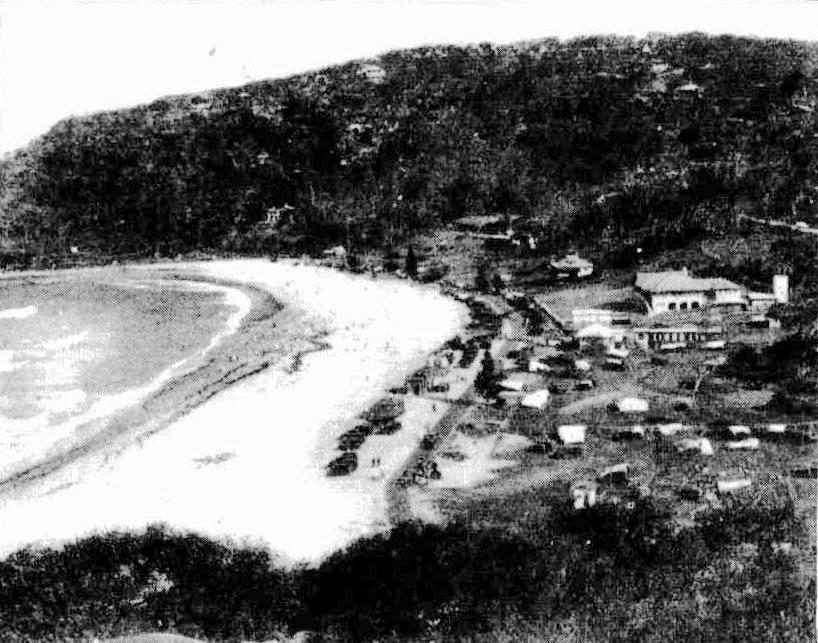
Motor camping, Palm Beach.

Motor camping, Palm Beach. (1930, January 10). Le Courrier Australien (Sydney, NSW : 1892 - 2011), p. 3. Retrieved from http://nla.gov.au/nla.news-article161727041
CAMPS AT PALM BEACH.
Insanitary and Overcrowded.
In consequence of complaints made by residents of Palm Beach, the Warringah Shire Council has Instructed its health inspector to draw up a scheme for the control of camping.
The complaints made to the council have not been in reference to the authorised camping areas, over which the council exercises authority, but relate to privately-owned lands on which camps have been set up. Many tents are set up without the permission of the owners of the land, and some are devoid of sanitary arrangements, besides being over-crowded.
Though the council's powers over privately owned land are limited, it Is hoped to take action that will prevent such overcrowding and compel campers to live under conditions that are not generally a menace to the health of the community. CAMPS AT PALM BEACH. (1930, January 15). The Sydney Morning Herald (NSW : 1842 - 1954), p. 19. Retrieved from http://nla.gov.au/nla.news-article16617848
VISUALISING THE CAMPERS' PARADISE
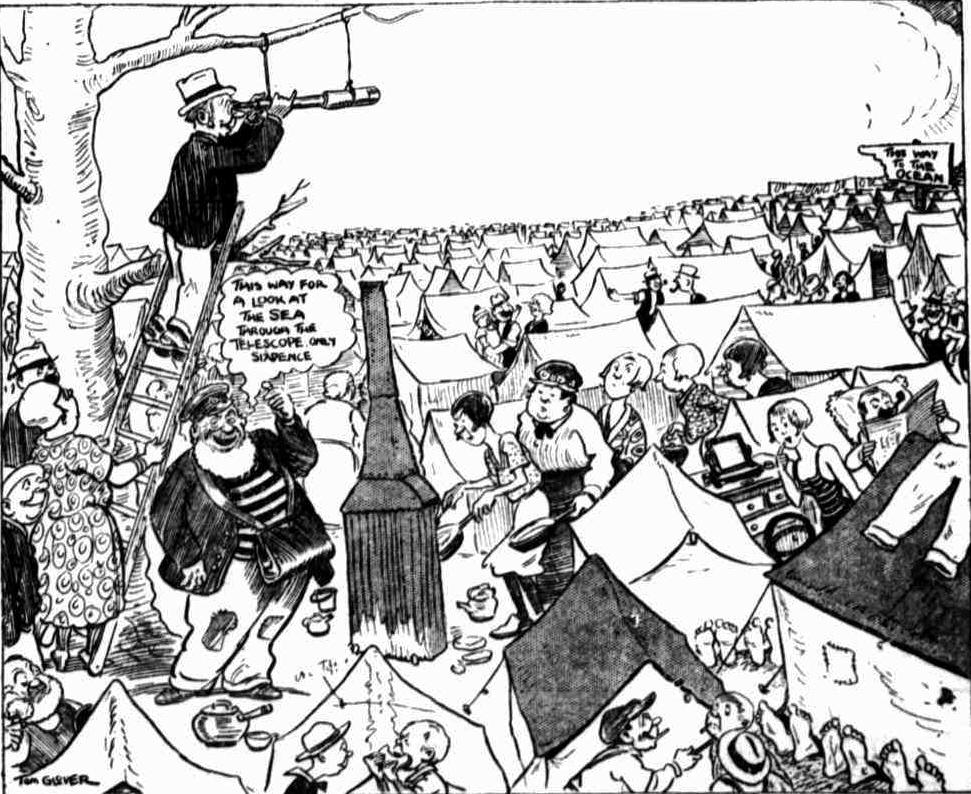
The Warringah Shire Council has received complaints about the crowded condition of the camping areas at Palm Beach. On some blocks more than 60 persons are living. Over 20,000 persons visit the beach on fine Sundays. What will it be like in five years' time? VISUALISING THE CAMPERS' PARADISE (1930, January 15). The Sun (Sydney, NSW : 1910 - 1954), p. 13 (LAST RACE EDITION). Retrieved fromhttp://nla.gov.au/nla.news-article226022076
PALM BEACH CAMPS.
PROSECUTION OF OFFENDERS.
The Warringah Shire Council has lost no time in dealing with unauthorised campers on vacant ground in the vicinity of Palm Beach. The health inspector (Mr. E. C. Starr) has already visited the localities complained of and those who set up camps with-out the councils authority will be prosecuted under section 70 of the Local Government Ordinances. Land agents are said to have been largely responsible for the state of affairs which rendered action necessary and in some instances having obtained sanction for the erection of one tent permitted the setting up of as many as half a dozen at rents as high as two guineas weekly for each tent. PALM BEACH CAMPS. (1930, January 16). The Sydney Morning Herald (NSW : 1842 - 1954), p. 8. Retrieved from http://nla.gov.au/nla.news-article16618139
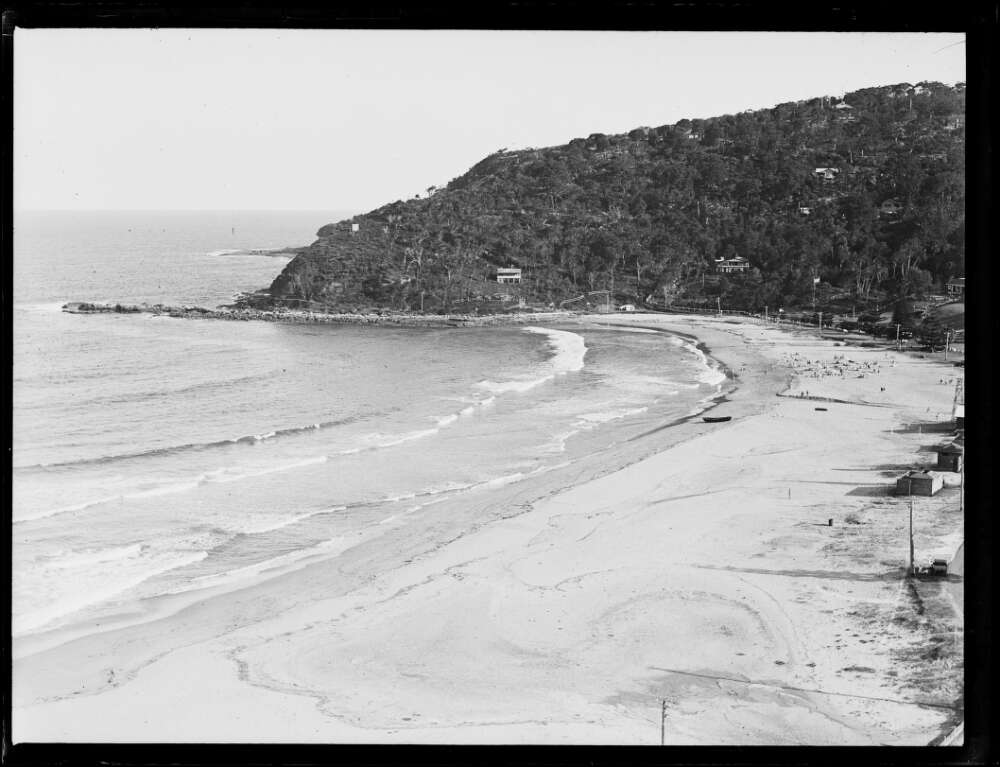
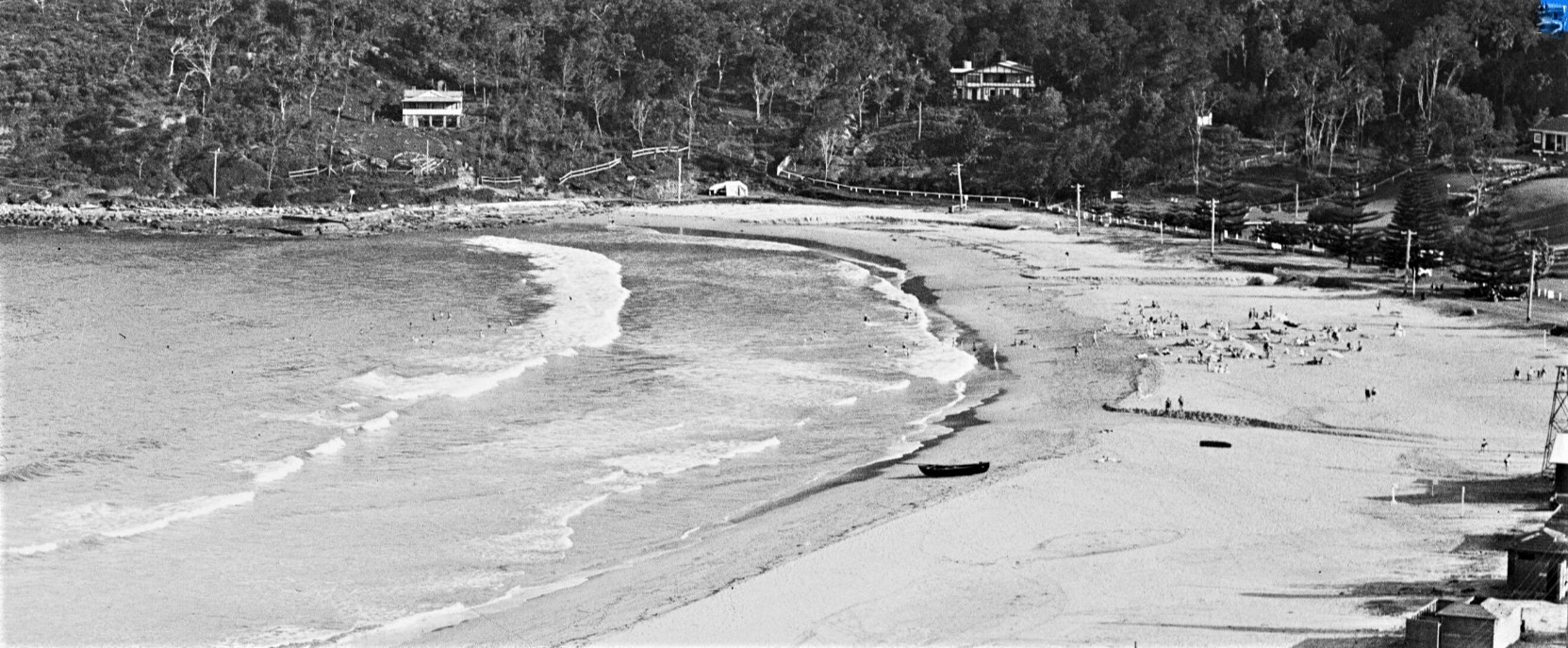
Fairfax Corporation. (1930). Houses on a hill at Palm Beach, New South Wales, ca. 1930s Retrieved from http://nla.gov.au/nla.obj-162441819 and enlarged section from
This one incidence clearly underlines the shift from rural towards urban and how those coming in assume precedence over those living permanently year round and servicing the local community with a staple - milk, especially during a time when milk was affordable for the many going hungry. Earlier residents such as Hermoinie Swainston, the Gonsalves and Verrills families, and even into the 1950's, in Ron Turton's recall, remember having a tin billy which a milkman would fill at their home gates:
PALM BEACH NUISANCE Straying Stock to Stop
Complaints of straying stock at Palm Beach have been the subject of protests to Warringah Council by the N.R.M.A., which is satisfied that the annoyance will soon be stopped. Action was first taken by the association some time ago, with satisfactory results, but recently further complaints have been received. In a letter to "The Sun" seeking assistance in securing relief from the straying stock nuisance, Mr. John S. Dence, of Palm Beach, suggests that the grazing of cattle within the golf links, camping reserve and beach areas should be prohibited. He Instances damage to gardens, hedges and ornamental trees in support of his protest, and says that 30 cows were counted on one day alone. PALM BEACH NUISANCE (1933, November 28). The Sun (Sydney, NSW : 1910 - 1954), p. 8 (CRICKET STUMPS). Retrieved from http://nla.gov.au/nla.news-article230196267
Gonsalves family home in Waratah Street, Palm Beach. From Verrills family album. Courtesy Peter Verrills
The cows and horses weren't the only beasts of burden grazing on the green tees:
THE CAMELIERS At Palm Beach.
EVEN CARRIED A PRAM.
Mr. and Mrs. Richard Jones and their 18 months' old son, Franklyn, whose-arrival from Central Australia was reported In the "Herald" yesterday, havemade their camp at Palm Beach. With them are their .camels, Beauty (a superior beast), Violet, Goldie (with permanent waves), and Sunnie (the spoiled baby camel, aged 3). There is also a perambulator, also from Central Australia.
Mr. Jones owns 100 other camels. Three years ago he came down, (by camel) from Innamincka, just over the Queensland border in South Australia, and was mnrrled to Miss Kathleen Elkington, of Newcastle. Their honeymoon was probably unique. They rode their camels from Sydney to Innamincka.
Last November Mr. Jones, his wife, and baby son travelled-still by camel-to Southport. After spending some months there they moved south, and reached Palm Bench last night. They had with them a tent, three heavy boxes, two stretchers, a petrol light, cooking utensils, and a perambulator.
Mr. Jones, who was born at Roma, Queensland, has spent most of his life-he is only 30 - in the back country. For some years he has conducted a wool and stores carrying business among the stations over the western Queens-land border. "I've known camels all my life, he said. "They are easy to handle when you know them, but they are quick to notice any change of mood In their rider.
Mrs. Jones said: "I sit side-saddle and carry baby in my lap. Before we start each morning he picks out his own camel. They love him and recognise him hundreds of yards away."
Mr. and Mrs. Jones will stay at Palm Beach until Easter at least. Beyond that their plans are uncertain. (Picture on Illustrations page.). THE CAMELIERS (1936, December 5). The Sydney Morning Herald (NSW : 1842 - 1954), p. 23. Retrieved from http://nla.gov.au/nla.news-article17297923
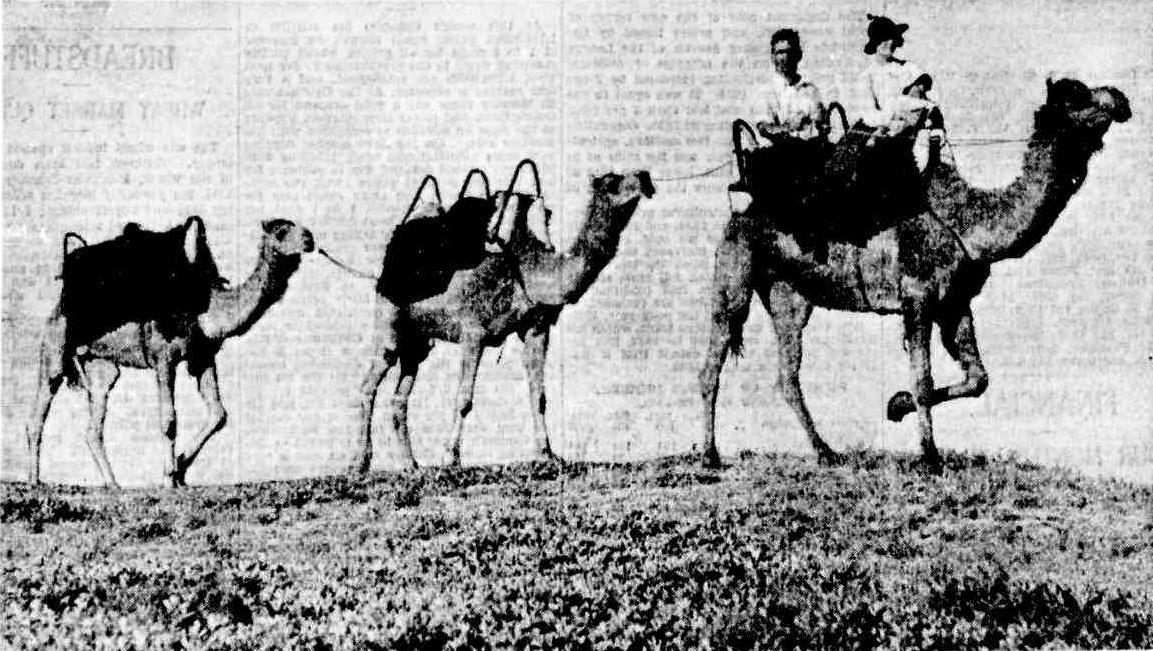
Above: Mr. and Mrs. Richard Jones and their baby son left their home in the Northern Territory in November last year and arrived for a holiday at Palm Beach yesterday. This is how they made the journey. MRS. FREER PEEPS AT SYDNEY — FIRST TEST MATCH BEGINS IN BRISBANE — AIR RAIDS ON MADRID. (1936, December 5). The Sydney Morning Herald (NSW : 1842 - 1954), p. 20. Retrieved from http://nla.gov.au/nla.news-article17298020
With Depression era work programs producing rock pool improvements locally, and road improvements as well, the way to get north and to where you could fish for your supper was made easier:
DANGEROUS TURN ELIMINATED.
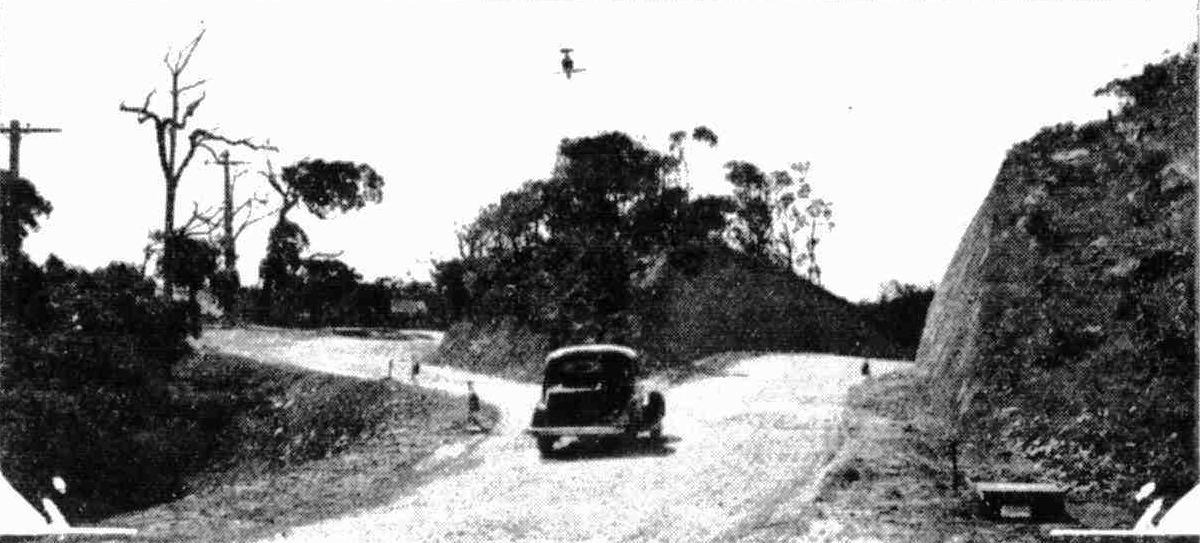
Extensive improvements are being made to the road to Palm Beach. This big cutting on the Newport-road has just been completed. The old blind turn, which was a source of danger when traffic was heavy, is on the left. Another cutting is being made at the northern end of Mona Vale. Tents and Motor-Campers (1935, November 20). Sydney Mail (NSW : 1912 - 1938), p. 50. Retrieved from http://nla.gov.au/nla.news-article160499041
HOLIDAY TRIPS. Popular Beauty Spots
GOOD CAMPING. For those motorists who wish to confine their holiday trips to beauty spots within an easy run the N.R.M.A. Touring Department to-day suggests a number of places where there are good camping and picnicking arrangements. In the districts north of Sydney, there are good picnic and camping grounds at Narrabeen, Avalon Beach and Palm Beach. At Lake Park Reserve, Narrabeen, under the control of the Warringah Shire Council, there is ample space for camping and picnicking. At Avalon Beach, the N.R.M.A. camp is immediately behind the surf beach, and is one of the finest camping grounds near Sydney. It is well sheltered on the eastern side, and there is a considerable area of clean grassy ground. Fishing, surfing, golf and tennis are to be had and between Christmas and New Year sports will be organised among the campers. Reservations are made through Mrs. Ralph, The Avalon Store ('phone Y9112).
PALM BEACH AREA
At Palm Beach camping is permitted on Governor Phillip Park, between the golf links and the ocean beach. This area is controlled by the Warringah Council, and fresh water and sanitation have been installed. Stores may be obtained nearby. Palm Beach is 25 miles from Sydney. There is a splendid surf beach close to the camp and still water swimming may be had on the Pittwater side. Fishing is usually good. This locality Is ideal for a summer holiday. HOLIDAY TRIPS. (1935, December 28). The Maitland Daily Mercury (NSW : 1894 - 1939), p. 10. Retrieved from http://nla.gov.au/nla.news-article127100097
Although the Warringah Shire Council, according to a recent press report, decided to allow camping at Bilgola Beach, the N.R.M.A. has since received advice from the council that its decision to allow camping at this place has been rescinded, and therefore motorists wishing to camp will have to patronise the recognised grounds at Narrabeen, Avalon Beach and Palm Beach. NEWS AND NOTES FROM THE N.R.M.A. (1936, November 13).Albury Banner and Wodonga Express(NSW : 1896 - 1939), p. 28. Retrieved fromhttp://nla.gov.au/nla.news-article112692495
RECORD CROWDS. BEACHES THRONGED.
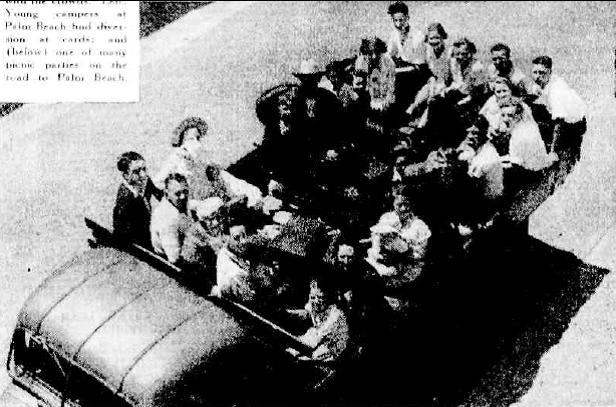
Trunks Generally Favoured by Bathers.
More than 100,000 people visited Sydney beaches yesterday. Five out of every six men bathed in trunks, in spite of regulations, and thousands of people travelled from their homes, on buses and trams, in shorts or playsuits over bathers, and dispensed with dressing sheds.
Figures for all beaches, based on turnstile figures at Coogee. Bondi, and Manly, where attendances reached record figures, were as follows:
Bondi . 30.000 Manly . 27,000 Coogee . 15,300 Bronte . 9,000 Clovelly . 8,000 Nielsen Park . 12,000 Balmoral . 9,000 Maroubra . 6,000 Palm Beach. 4,000 Newport 4,000 Deewhy . 4,000 Collaroy 5.000 From the point of view of styles In beach wear and beach customs, the day set a new standard in modernity.
THE SPEED LIMIT.
The 30 mile an hour speed limit did not apparently inconvenience the traffic to and from the beaches. Motorists in general seemed i to be travelling at the usual pace.
Clear skies and a fresh breeze early in the morning roused people from their beds, eager to get down to the beaches before the weather changed. Most of the beaches close to the city were crowded early in the morning. By 11 a.m. a steady stream of traffic was beginning to move out to the farther beaches.
PALM BEACH POPULAR.
Palm Beach was a popular goal for holiday-makers. Its usual holiday population of house parties was amplified this Christmas by an even larger 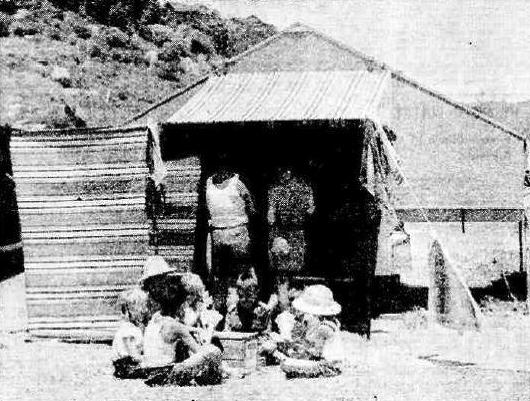 colony of trailers and camping motorists. Every site on the camping reserve was occupied. Some of the trailers and caravans were of remarkable design.
colony of trailers and camping motorists. Every site on the camping reserve was occupied. Some of the trailers and caravans were of remarkable design.
The scene, with the surrounding green country, the rich coloured sand, the gay parties of sunburnt people in bright swimming costumes under rainbow sunshades, and the background Of white and blue surf, was like something out of a well-produced revue.
Here, one felt, the holiday was more than a chance to Iie in the sun and swim in the surf. It was a fashion parade as well, and it was Sydney's first massed gala parade In the world's most, modern costumes.
ROLLICKING SURF.
By midday a brisk breeze had worked up a rollicking surf all along the coast. Rubber floats were at a premium. All the morning at Palm Beach, Newport, Avalon, and Deewhy, a steady Stream of traffic kept bringing more surfers. They arrived in every form of conveyance; there was even an odd sulky here and there on the road. There were several open lorries, their rattling boards populated by families out to have a good time at any price. There were cyclists by the hundred. Motor cycles flashed through the traffic with girls in shorts bouncing on the pillions. There were cars that could hardly crawl up the hills filled to capacity with family parties and everybody's luggage strung on the back. There were sleek, high-powered cars dashing In subversive spurts of 60 miles an hour through the 30-mile speed limit areas.
RECORD CROWDS. (1937, December 27). The Sydney Morning Herald (NSW : 1842 - 1954), p. 7. and p.10 photographs: (Titles: Young Campers at Palm Beach had diversion at cards and Above: one of many picnic parties on the road to Palm Beach) Retrieved from http://nla.gov.au/nla.news-article17439253
A Lease proposal - visit - Barrenjoey the Lessees
BARRENJOEY PROJECT Opposing Views At Palm Beach
Palm Beach opinion Is sharply-divided as to the results of the reported lease of Barrenjoey Headland; to an American syndicate. It is said that the Federal Government has already granted the lease, and that the syndicate will spend £200,000 on cabins for holiday-makers. "That expenditure should be very welcome to Palm Beach, provided, of course, that it Is spent In a way approved by the authorities," declared the chairman of Palm Beach Lands, Ltd. (Mr. R. J. McKay), today. "Transport and sporting facilities would probably be Improved. I don't think it would depreciate land values. This, however, Is the opinion only of myself and the firm I represent." "We don't like It at any price," said Mrs. S. B. Hooper, secretary of Palm Beach Progress Association. Land values, she added, would slump Immediately, and Palm Beach would become a commercialised business place, losing all the natural beauty and isolation that has made it an attractive holiday resort. BARRENJOEY PROJECT (1938, August 1). The Sun (Sydney, NSW : 1910 - 1954), p. 3 (LATE FINAL EXTRA). Retrieved from http://nla.gov.au/nla.news-article229128008
PALM BEACH Council Is Against Any Lease
SYDNEY, Wednesday Warringah Shire Council last night resolved to ask the Minister for Lands, Mr. Sinclair, to reject the application by Mr.F. J. Terry e lessee of Barrenjoey Headland for a lease of 12 acres of Crown land reserve adjoining, through which he desires to provide access to the headland from the Palm Beach Road.
Mr: Terry , who has leased the land from the Department of the Interior, said yesterday that it was proposed to erect, not holiday cabins, but substantial improvements for residential and entertainment purposes. The lease of 70 acres, covering the whole of the headland except for some small areas around the lighthouse and the memorial cairn, was for 50 years, and subject to stringent conditions, which he had assured the department would be carried out.
Mr. Terry added that he held the lease personally. It had been granted after the area had been advertised for leasing in September last year. PALM BEACH (1938, August 3). Goulburn Evening Penny Post (NSW : 1881 - 1940), p. 7 (Daily). Retrieved from http://nla.gov.au/nla.news-article102418792
BARRENJOEY LEASE. Inquiry Probable.
An inquiry will probably be held by the Metropolitan Land Board into the application by Mr. F. J. Terry for a lease of 12 acres of Crown land reserve adjoining the Barrenjoey headland. Mr. Terry, who has leased the greater part of the headland from the Federal Government, desires the new lease in order to give access to the headland from the Palm Beach Road. The inquiry may not be held for sometime. The matter will not be considered at the board's next sitting on August 23and future sittings are fixed by the chair-man. The Minister for Lands has power to approve a lease, but rarely exercises it, except where his approval is purely formal. Where objections have been raised, as in this instance, an inquiry is usual.
Captain M. J. Lowe, president of the Manly, Warringah, and Pittwater Historical Society, said yesterday that his members had an interest in Barrenjoey Peninsula, because of the historical memorials ejected there. They had received an assurance from Mr. Terry that these would be protected and cared for. Apart from these memorials, the society had no reason for concern.
"We are not likely to stand in the way of progress or development," Captain Lowe said.
On the headland is an obelisk marking the site of the first Barrenjoey lighthouse, and alongside the present light is the Gledhill Lookout. On the sand spit, adjacent to Governor Phillip Park, is a cairn commemorating the naming of Pittwater by Phillip on March 3 1788.
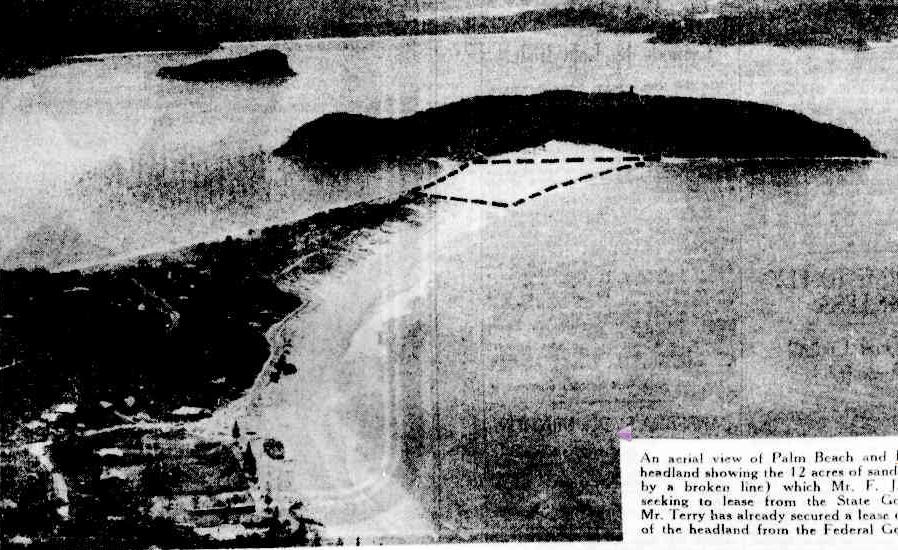
An aerial view of Palm Beach and Barrenjoey headland showing the 12 acres of sand (enclosed by a broken line) which Mr. F. J. Terry is seeking to lease from the State Government. Mr. Terry has already secured a lease of 70 acres of the headland from the Federal Government. Copies of pictures by "Sydney Morning Herald" photographers may be purchased from the Art Gallery at the "Herald" Office. Scale of charges may be obtained on application. BARRENJOEY LEASE. (1938, August 4). The Sydney Morning Herald (NSW : 1842 - 1954), p. 11. Retrieved fromhttp://nla.gov.au/nla.news-article17489009
BARRENJOEY HEAD. Council Against Access. LESSEE DEFENDS SCHEME.,
Warringah Shire Council last night resolved lo ask the Minister for Lands Mr Sinclair to reject the application of Mr Terry leasee of Barrenjoey Headland for a lease of 12 acres of Crown land reserve adjoining through which he desires to provide access to the headland from the Palm Beach Road. Mr Terry who has leased the area from the Department of the Interior said yesterday that it was proposed to erect not holiday cabins but substantial improvements for residential and entertainment purposes. The lease of 70 acres covering the whole of the headland except some small areas round the lighthouse and the memorial cairn was for 50 years and subject to stringent conditions which he had assured the department would be carried out.
Mr Terry added that he held the lease personally. It had been granted after the area had been advertised for leasing in September of last year. To make the use of it he proposed it was necessary to get access to it from the main road leading to Palm Beach. He had made application to the State Lands Department for a lease for a period of 28 years of 12 acres of the Crown Lands Reserve south of the headland. The area applied for was a barren wind swept sand dune.
Financial organizations it is understood are interested in the proposal which involves expenditure of upward of £100 000.
The matter was brought under the notice of the Council by the acting metropolitan district surveyor Mr. Max Allen who said that the purpose of the application in desiring a lease of the land was to use it for recreation and parking. Mi Terry had supported his application by representing that the area was required in conjunction with the Barrenjoey Headland which he had leased from the Commonwealth Government and that a comprehensive scheme for improvement was contemplated.
The council was asked to advise the Land Board if they objected to the granting of Mr. Terry's application.
There was also a letter from Mr. P C Spender MP who said he was definitely opposed to any amusement area week-end camps on Barrenjoey Headland and was protesting to the Federal Government on the matter.
Councilor Campbell said that if the lease was granted by the Lands Department, the land might never come back to the council. It would be against the public interest to hand it over to private enterprise. Councilor Latham asked the council to allow the matter to stand over until details of the other lease were obtained from the Federal Government. This was defeated in favour of a motion by Alderman Campbell to oppose the granting of the lease. The Council had previously forwarded a protest to the Federal Government against the leasing of the Barrenjoey Headland for the purposes of private enterprise. BARRENJOEY HEAD. (1938, August 3). The Sydney Morning Herald (NSW : 1842 - 1954), p. 16. Retrieved from http://nla.gov.au/nla.news-article17495840
BARRENJOEY LEASE. Defence Interests Have Been Safeguarded.
The Minister for Defence, Mr. Thorby, said yesterday that the lease of Commonwealth land granted to Mr F. J Terry on Barrenjoey headland, wassubject to the right of the Commonwealth to re-occupy the land at any time if it was needed for defence purposes. The land Mr. Thorby said, had not been all a Defence reserve but the Defence Department had been consulted when it was proposed to lease it. and had raised no objection. After tenders hand been called by two announcements in the Commonwealth Gazette, the land excluding 10 short tenancies which had been granted previously, had been leased to Mr Terry for 50 years, from June 1 last, for the purpose of establishing a tourist resort. BARRENJOEY LEASE. (1938, August 5). The Sydney Morning Herald (NSW : 1842 - 1954), p. 11. Retrieved from http://nla.gov.au/nla.news-article17493285
BARRENJOEY LEASE. Proposed Buildings. MR. SPENDER, M.P., SEEKS INFORMATION.
The Assistant Minister for the Interior, Mr. Thompson, in a letter to Mr. Spender, M.P., stated that tenders for the lease of about 70 acres of land at Barrenjoey had closed on April 4. Mr. F. J Terry, the successful tenderer, had intimated that he proposed to establish a holiday recreation and entertainment area with club facilities and attractions. Mr. Thompson added that the Commonwealth was committed to lease the area to Mr. Terry. It was considered, however, that the proposed conditions of the lease would reasonably safeguard the interests of the public. Mr Spender, in a letter to the Minister, directed attention to the condition of the lease which required, apparently, that the sanction of the Commonwealth must be obtained before any buildings were erected. He asked the Minister for information about the type of building and facilities which the department would permit, and suggested that before approval was given the advice of the Warringah Shire Council should be sought. BARRENJOEY LEASE. (1938, August 13). The Sydney Morning Herald (NSW : 1842 - 1954), p. 16. Retrieved from http://nla.gov.au/nla.news-article17488203
BARRENJOEY LEASE. Opposition by Parks Movement. The committee of the Parks and Playground Movement: BARRENJOEY LEASE. (1938, September 22). The Sydney Morning Herald (NSW : 1842 - 1954), p. 13. Retrieved from http://nla.gov.au/nla.news-article17521106
BARRENJOEY LAND. Minister Refuses Lease. 20 ACRES OF PUBLIC RESERVE.
The Minister for Lands, Mr. Sinclair, has refused the application by Mr. F. J. Terry for a lease of 20 acres of public reserve adjoining land on Barrenjoey headland already leased to Mr Terry by the Commonwealth. Mr. Terry said yesterday that he was negotiating with the Warringah Shire Council for the making of a road to the headland as shown on a sketch map attached to the lease from the Commonwealth Government. On the plan the road is shown running through the park area on the Pittwater side where the golf links are located. Mr Terry stated that he believed that the Minister had refused his application without being aware of all the circumstances, and he intended to re-apply for a lease of 20 acres of what he described as the sand dunes. The Warringah Shire Council which opposed the granting of the lease will discuss the matter again at Its meeting tonight. BARRENJOEY LAND. (1938, September 27). The Sydney Morning Herald (NSW : 1842 - 1954), p. 11. Retrieved from http://nla.gov.au/nla.news-article17522639
Undaunted, Mr Terry pursued his, or his syndicates, agenda:
SURVEYOR FALLS OVER CLIFF. Lucky Rescue When Tossed On Ledge By Wave SYDNEY, December 13.
Mr. W. C. Duffy, 52, of the survey branch of the Department of the Interior, received serious injuries to his spine today when he fell several feet over a cliff into the sea near the Barrenjoey lighthouse and was tossed about in the breakers until a wave hurled him back on to a ledge of rack. Mr. Duffy was engaged with several others on survey work near the lighthouse when he slipped. His rescue seemed a hopeless task until a wave lifted him back to the rocks. He was then unconscious. An improvised stretcher was made by fixing bags to two poles and on this Mr. Duffy was carried about: a mile over rocks and up a dangerous track to a wharf not far from the lighthouse., As Saturday's hurricane had broken all the telephone lines in the district, a messenger had to go four miles to telephone the Manly ambulance. This meant a delay of nearly two hours. There was no road to the wharf, and the ambulance wagon had to be left nearly a mile from where Mr. Duffy was lying. SURVEYOR FALLS OVER CLIFF. (1938, December 14). The Advertiser(Adelaide, SA : 1931 - 1954), p. 27. Retrieved from http://nla.gov.au/nla.news-article36600416
From Warringah Shire Council minutes of Meetings:
6o. F.J.Terry, 26/4/39, submitting proposal for the leasing for a period of 15 years, of the Whole of the area of about 50 acres at Palm Beach adjoining his lease at Barrenjoey, and Peninsula including the golf links. "Received' (era. Sterland, Lands Hitchcock) An amendment moved by Cr. Butcher, seconded by Cr. Campbell, that consideration be.deferred until after the Special Meeting was lost. From Warringah Shire Council Minutes.
37. Palm Beach Progress Assoc., 27/9/39, stating it is understood the proposed lease of Barrenjoey Reserve to Mr. Terry has not yet been completed, and suggesting that a further protest be submitted against the granting of the lease. Resolved - That a further protest be made to the Federal authorities, as requested. (Crs. Hitchcock, Savage)
47. F. J. Terry, 15/12/39, requesting permission to carry a water pipe line from the main through Governor Phillip Park to-his property at Barrenjoey. Resolved, - That permission be granted, subject to the Engineer’s approval.
F. Terry, 3/1/40, forwarding plan showing proposed road along the foreshores of Barrenjoey, and indicating the water pipe line from Beach Road to Barrenjoey. Referred to the Works Committee for report.
In 1940 the headland became an essential part of Sydney’s defence in WWII and under the Dept. Of Defence. All claims on these lands would have been cancelled. No more about what happened to Mr Terry’s 50 year lease can be found at this stage.
The camping ground was also popular with families that came to Palm Beach for the summer season. Ian Curlewis, son of 'the father of Australian Surf Life Saving' Adrian Curlewis, related to us a few years ago how much he enjoyed staying there during summer holidays. As did many others, coming back year after year for decades and succeeding generations, or three generations together:
Celebrating Christmas In Canvas City
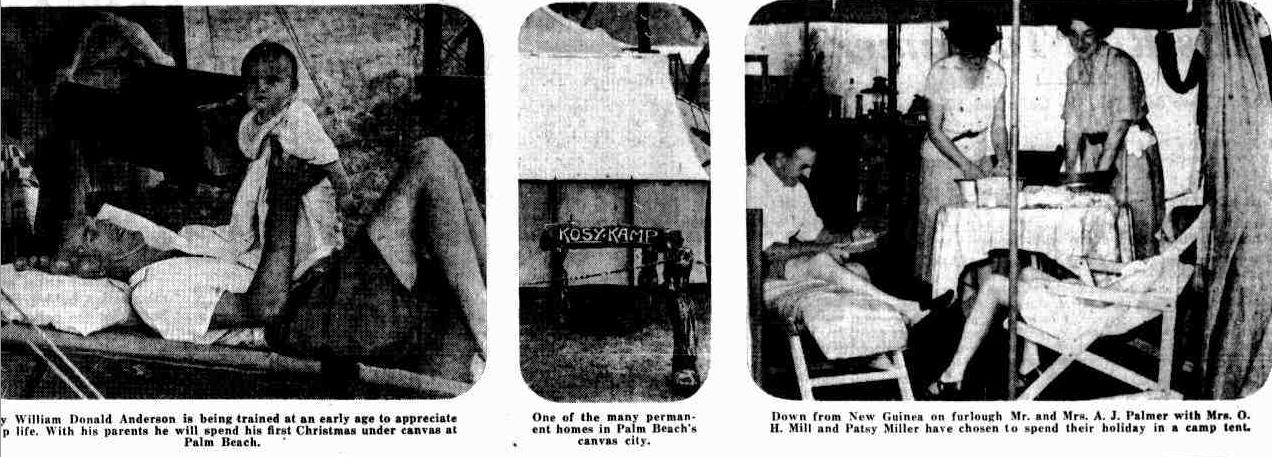
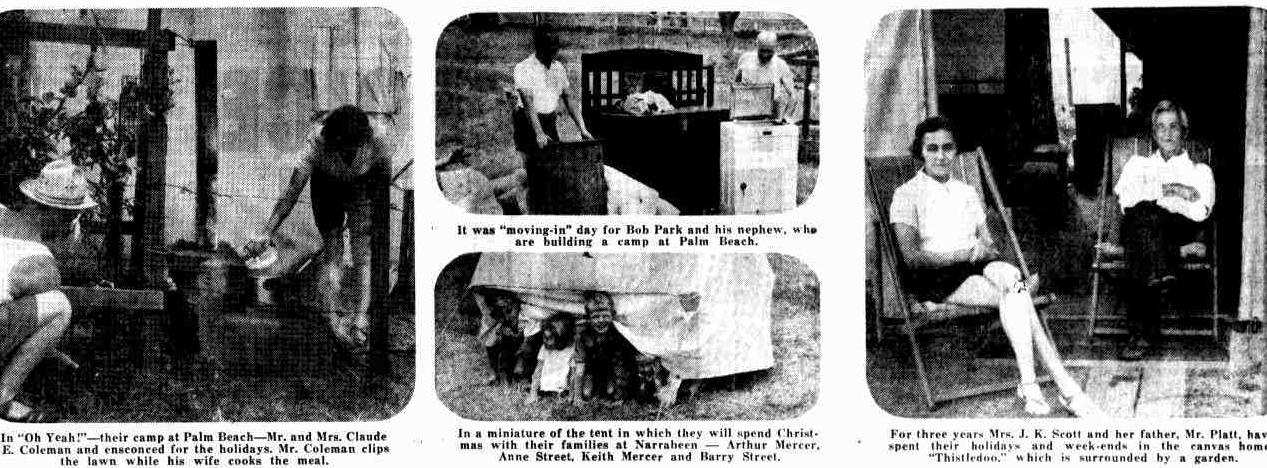
Celebrating Christmas In Canvas City (1938, December 25). The Sun (Sydney, NSW : 1910 - 1954), p. 5. Retrieved from http://nla.gov.au/nla.news-article231134058
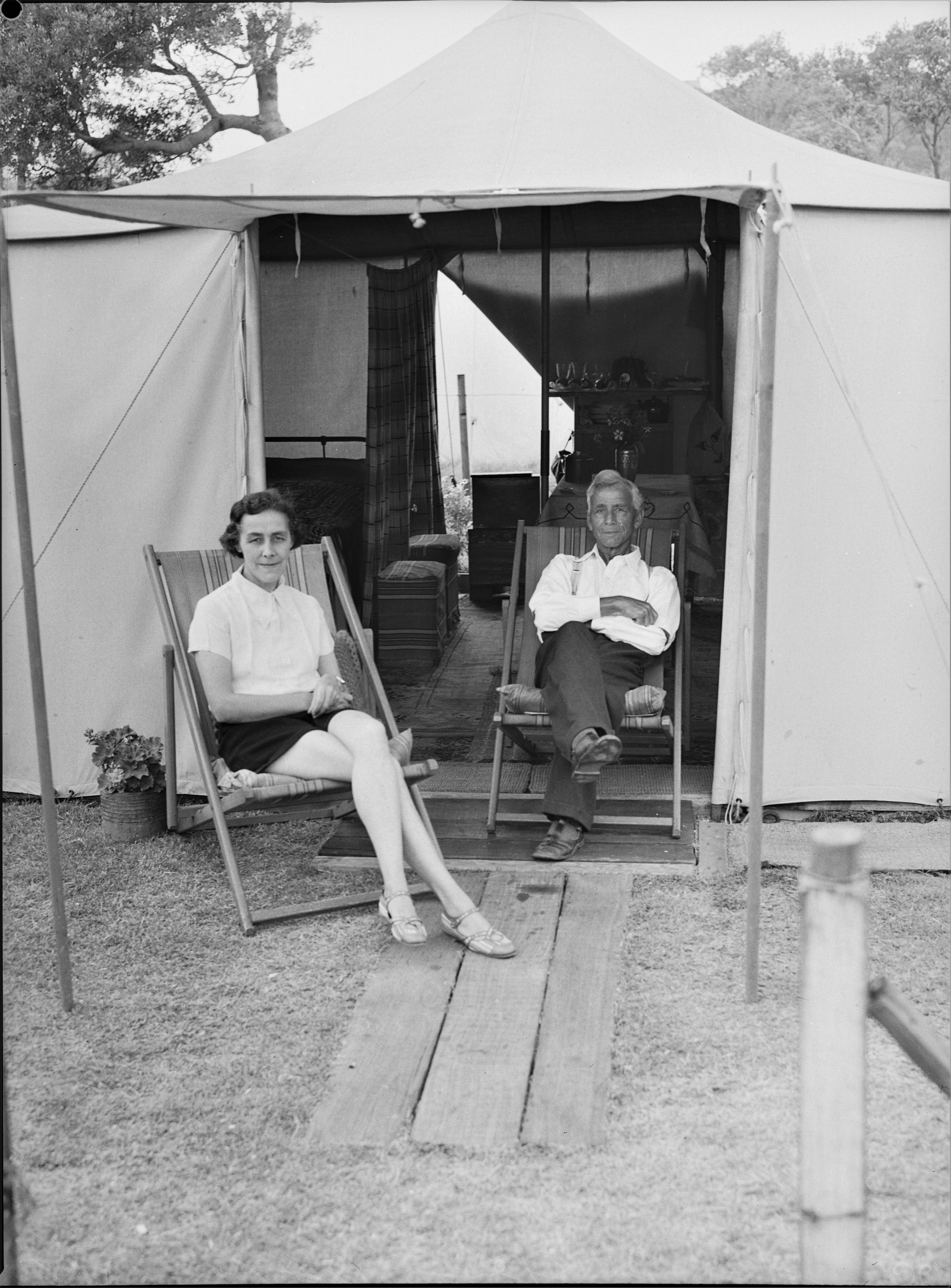
Mrs J K Scott and her father Mr. Platt from Album 'Xmas campers at Narrabeen & Palm Beach, 21 December 1938 / photographs by Ted Hood, SLNSW_FL19113981 courtesy State Library of New South Wales.
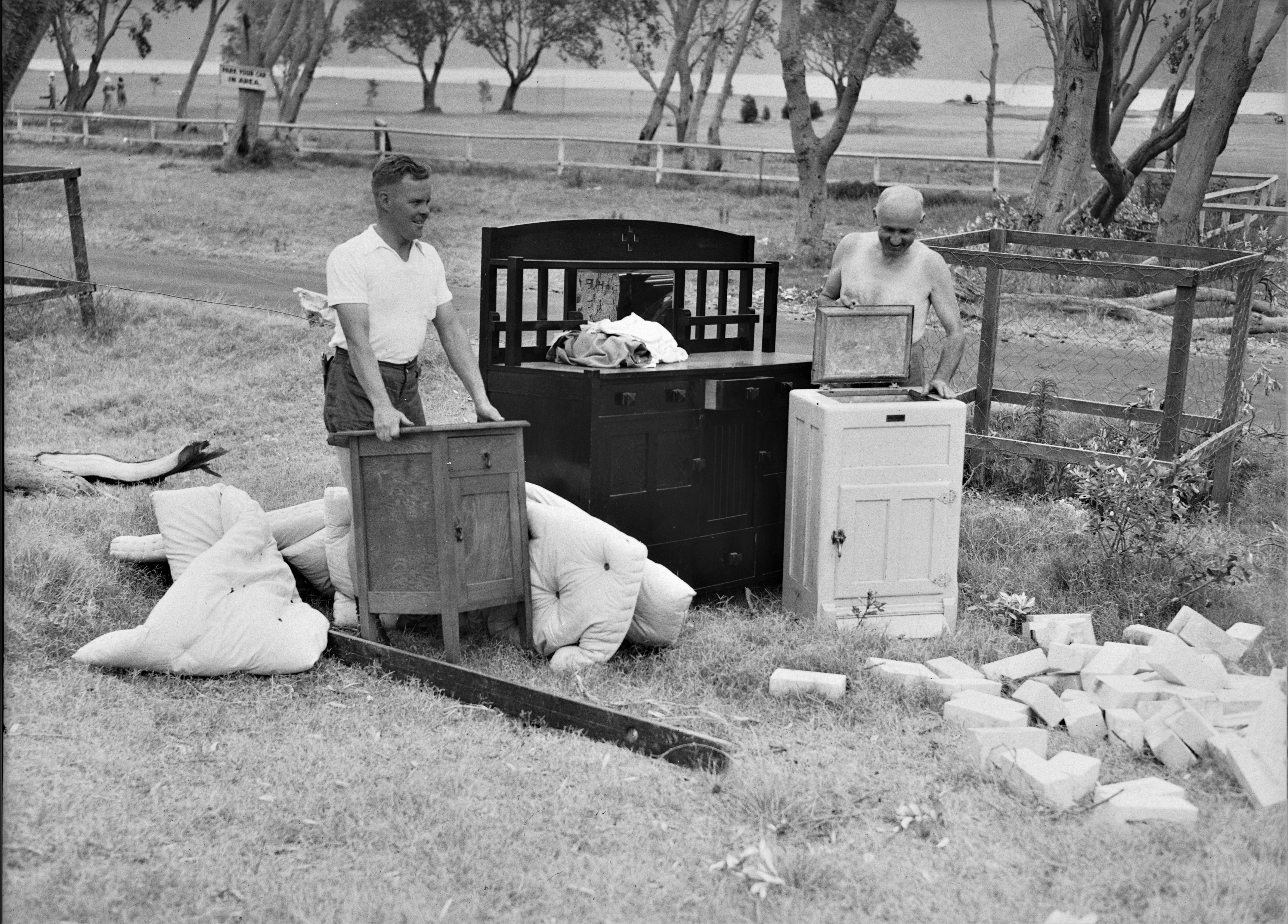
Bob Park and his nephew from Album 'Xmas campers at Narrabeen & Palm Beach, 21 December 1938 / photographs by Ted Hood, SLNSW_FL19113978 courtesy State Library of New South Wales.
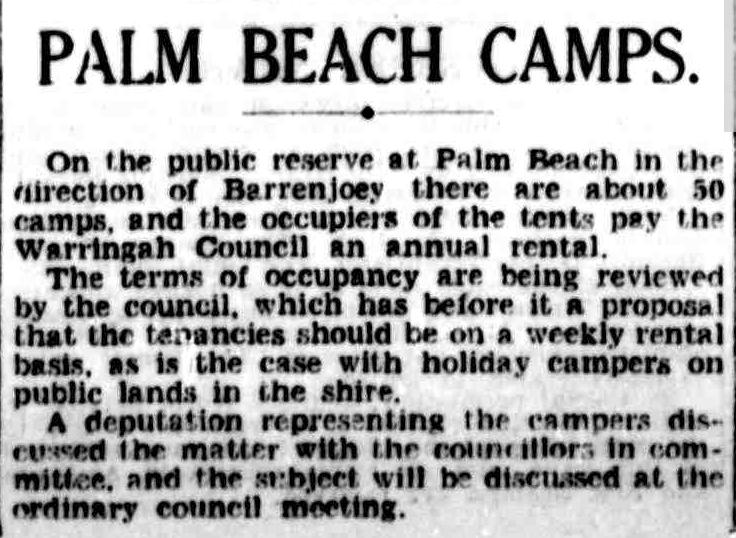
PALM BEACH CAMPS. (1940, February 29). The Sydney Morning Herald (NSW : 1842 - 1954), p. 10. Retrieved from http://nla.gov.au/nla.news-article17660518
CAMPERS AT PALM BEACH Must Now Pay Rent.
Campers on the public reserve at Palm Beach will in future have to pay an annual tent of from £6 to £9 according to the size of their allotment. Warringah Shire Council made this decision last night on the casting vote of the president Councillor Green. An alternative proposal before the meeting was that campers on the area should pay a weekly fee similar to charges made else-where in the shire Notice of a rescission motion was given for next council meeting.
At present 54 campers are on the Palm Beach area where there is room for about 150 sites. Nine new applications were received at the council meeting. CAMPERS AT PALM BEACH (1940, March 21). The Sydney Morning Herald (NSW : 1842 - 1954), p. 12. Retrieved from http://nla.gov.au/nla.news-article17664606
A series of near accidents caused some of these campers and local families to form patrols at this end of Palm Beach. In 1939 the North Palm Beach Surf Life Saving Club was established, originally set up in the Beacon Store (located opposite the current Barrenjoey Boatshed).
During WWII the troops of the 18th Battalion were based on Barrenjoey Headland and reported every hour to their Headquarters at St Ives using the telephone from the Beacon Store. Post WWII there was an increased amount of urban development on the Peninsula and the popularity of camping at Governor Phillip Park increased.
VOLUNTEER DEFENCE CORPS.
Week-end Parades. Nearly 800 members of the Volunteer Defence Corps, In the 17th Battalion area, which extends from North Sydney to Palm Beach, paraded at French's Forest Showground yesterday afternoon, under Colonel Travers. The men were inspected by Major-General Gordon Bennett, Commandant, of the Training Depot, Eastern Command, who later took the salute in a march-past. He praised the physique and marching of the men.
Major-General Bennett also attended a parade of the Kuring-gai Gai Battalion of the Home Defence Corps, held yesterday morning at Killara. More than 200 men of B Company paraded under Major Pinnock. It was their first combined drill, and General Bennet complimented them on their performance…VOLUNTEER DEFENCE CORPS. (1940, July 15). The Sydney Morning Herald (NSW : 1842 - 1954), p. 11. Retrieved fromhttp://nla.gov.au/nla.news-article17687421
It seems that the North Palm Beach Aussie larrikin spirit was infectious, even during wartime:
"Bomb" Thrown At Minister. SYDNEY. Thursday.-The Minister for the Army (Mr. Spender) was attacked yesterday by military forces with a bomb. The forces were a contingent of the A.l.F. travelling in an army lorry from leave at Palm Beach, north of Sydney, and the bomb was a bag of flour. A direct hit was scored, and Mr. Spender's driver was smothered in flour. The occupants of the lorry did not recognise Mr. Spender, and as his car drew alongside the lorry the flour bomb was thrown with precision through the front window, where it burst over the driver. Mr. Spender, who came unscathed through the attack, does not view the incident seriously. Having pacified his driver.- who wanted to pursue and annihilate the occupants of the lorry, he. resumed his Journey to Sydney. "Bomb" Thrown At Minister. (1941, January 23). Barrier Miner(Broken Hill, NSW : 1888 - 1954), p. 5 Edition: HOME EDITION. Retrieved from http://nla.gov.au/nla.news-article48413593
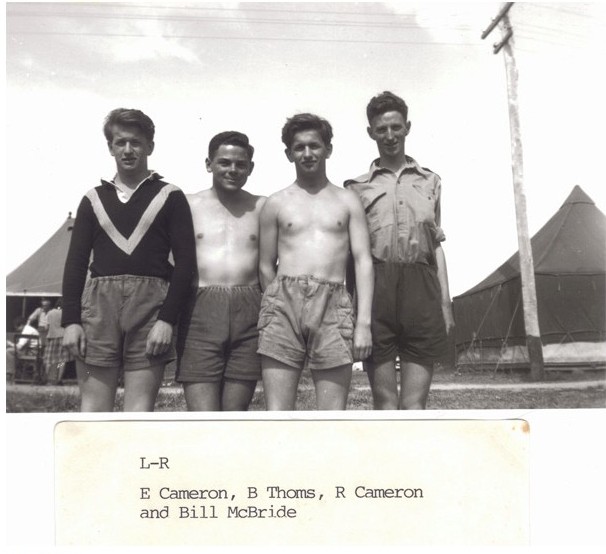 NEWS AND NOTES FROM THE N.R.M.A. Camping Permits. .Following complaints from the N.R.M.A. that genuine holiday campers and picnickers were being prevented from enjoying public reserves at various popular seaside resorts, the Minister for Lands has decided, as a matter of general policy in regard to seaside reserves, that no further sites for cottages or any structure with a semblance of permanency should be made available by the trustees.
NEWS AND NOTES FROM THE N.R.M.A. Camping Permits. .Following complaints from the N.R.M.A. that genuine holiday campers and picnickers were being prevented from enjoying public reserves at various popular seaside resorts, the Minister for Lands has decided, as a matter of general policy in regard to seaside reserves, that no further sites for cottages or any structure with a semblance of permanency should be made available by the trustees.
Warringah Shire Council has been advised of the policy laid down by the Minister, and informed that he desires it to refrain from granting permits for camping on Governor Phillip Park at Palm Beach for other than temporary occupation for holiday purposes, and that no extension of the permits, which have been granted for periods of 12 months, be granted by the Council.
Commenting on the decision, the general secretary of the N.R.M.A. (Mr. H I Johnson)said that owing to the granting of permits to about 50 people for permanent residences at Governor Phillip Park, many genuine holiday campers found it impossible last summer to obtain good camp sites. At various reserves on the North Coast permanent structures had been erected, including cottages and even stores. THE MOTOR WORLD. (1940, July 9). The Braidwood Review and District Advocate (NSW : 1915 - 1954), p. 8. Retrieved from http://nla.gov.au/nla.news-article119345081
Right: founding North Palm Beach SLSC were from the campsites at Palm Beach
Warringah Shire records indicate the life savers at this north end of Palm Beach were originally called 'Barrenjoey Beach' .
Warringah Shire Records:
31. 18/3/1941: Barrenjoey S.L.S. Club, requesting permission to erect a small structure in a central position overlooking Barrenjoey surf beach for the housing of a surf reel, box line and for life - saving gear, the structure to be a temporary one-as-it is the Club's intention to seek the Council’s permission to erect a Clubhouse at some future date if circumstances permit the surf club to remain in being, and to supply active patrols Saturdays Sundays and holidays (b) stating the Palm Beach Golf Club-has given the Club its shelter shed at No 4 tee and if the Council approves, the Club will re-erect this building. Resolved: that the Council agree to the proposal provided that the Works Committee of the site after an inspection in company with the club’s representatives.
16/12/1941: 4. Re Proposed appointment of Caretaker at Palm Beach wharf, and reporting that Mr. Ward, of Barrenjoey Road, Palm Beach, was prepared to take the position at £1 per week: Resolved, - Palm Beach That an effort be made to catch the offenders who tie up their boats to the wharf, with a view of prosecuting them. (Crs. Hitchcock, Langdale)
66. Barrenjoey S.L.S.Club, 25/11/41, requesting that the front portion of the recently erected surf sheds at Barrenjoey Beach be enclosed for the purpose of protecting the life saving gear, and offering to bear the cost if the Council will carry out the work. Received, - That the request be complied with, and the Council carry out the work at the expense of the Club. (Crs. Bathe Hitchcock)
17/3/1942: By Cr. Hitchcock - The box line outfit at Barrenjoey Peninsula has been damaged by vandals: Could this be attended to The President said the Inspector would attend to the matter.
This item shows an ongoing wish by some to have the camp closed and Australian Depression making many homeless and post war shortages keeping them that way, being accomodated along with changes that happened within the Reserve:
Campers To Stay
Because they are playing a useful part in the development of the area, "the Minister for Lands (Mr. Tully) does not intend to disturb all the campers at Palm Beach. Those whose camps are on the six acres which are to be made into a park will have to move, but others can remain on a weekly tenancy of 10s a week.
"I was asked to remove all the campers," Mr. Tully said today, "but I have found that these men are keeping orderly camps, which in no sense are an eyesore.
"Some of them are members of the local golf club, and others are prominent members of the life-saving club which saved six lives last year. Campers To Stay (1941, September 9). The Sun (Sydney, NSW : 1910 - 1954), p. 4 (LATE FINAL EXTRA). Retrieved fromhttp://nla.gov.au/nla.news-article231623359
MOTOR CAMPING Forced by petrol rationing to stay close to home, motor campers gave extensive patronage to popular grounds near Sydney over the Christmas-New Year period, reports the N.R.M.A. At the four main camps under the control of Warringah Shire Council--at North Curl Curl, Narrabeen, Avalon and Palm Beach there were 542 camps, containing over 3000 people. MOTOR CAMPING. (1943, January 12). The Canberra Times(ACT : 1926 - 1995), p. 4. Retrieved from http://nla.gov.au/nla.news-article2616911
A description from a regular visitor of camping at Palm Beach towards the end of WWII
Ah Me-The Beauties Of Nature!
By JUDY TUDOR
BETWEEN the ropes of the tent peeked the blue Pacific, and a golden, sandy crescent of perfect beach. Giant combers broke off-shore in swirls of turquoise shot-silk and lacy frills. A white yacht dipped her sails to the nor'easter; a smudge of freighter smoke broke the long line of horizon. To the left, old Barrenjoey-a solid bulk of brown-green-black, a broth of breaking sea at her feet, and the pygmy figures of the rock-fishermen already at work. Across the isthmus, Pittwater shone like a blue jewel in a setting of green hills. Over all, the morning sun shed a bland munificence.
The time-sometime between Christmas and New Year: the place-Palm Beach camping reserve; the spot, the water queue, which in order of the day's chores came after the bread and milk queues. "Just like home." said one woman.
SEVERAL months ago, I, with the help of a car, a month's ration of petrol, and several friends, hauled a war-stranded caravan onto the sandy Isthmus at Palm Beach; it made a good week-ender. Down below was the regular camping area. grass grown, level, sheltered, but populous with permanent week-end campers. Like the Garbo, but for slightly different reasons, I wanted to be alone in my contemplation of nature, and took all the howling winds that blew, all the salt-sea spray of the sandy dune-strip rather than that regular camp. From the caravan windows: fore, was the. limitless Pacific, aft. blue Pittwater.. A kindly belt of scrub screened the campers from below, and although civilisation was just over the brow, there-was sufficient of splendid Isolation to please anyone who had an unholy desire to get Pitt Street out of the lungs and fellow humans out of the hair at regular intervals.
That was In October. In November, they (meaning some authority, municipal, shire, or governmental), came with a tractor and went to work. The carefully nurtured marun grass and other sand-growing shrubs were wrenched ruthlessly from the sandhills they helped bind together; the tips of the dunes were scraped down into approximate levelness; and hundreds of brand-new numbered pegs were driven at Intervals of a few feet Into the now loose, shifting sand. The scene was set for them to earn ten shillings per campsite per week from Christmas campers. (Or any camper between December and Easter; 3/ at other seasons.)
BY Christmas Eve, the once deserted dune-strip, with its car-width, of solid road, was covered thicker than a rash with everything in the way of canvas, and here and there a caravan was pushed adventurously on to semi- solid pockets in the loose sand. Tent ropes interlaced; and should the baby howl, papa snore or mama cough, then six neighbours close-packed around were Intimately aware of it. Family altercations were heard ten tents distance. The top water tap was almost within the portals of one tent; a portable washstand, festooned with tooth-brushes and pieces of soap, had to be negotiated before you could draw water. In and about this mushroom canvas-town, hundreds of people, in the sacred cause of holiday, had their temporary being. The fastidious might call it squalor, but the hardy spirits apparently called it fun.
Some campers came in huge lorries and brought literally everything from incredibly ancient grandparents to ice chests, carpets to lay on the sand, electric lighting outfits, wooden bedsteads, wardrobes, radios, and the kitchen stove. Some did it the hard way, with no more equipment than could be packed into a swag, candles for illumination, and a square of canvas to crawl beneath.
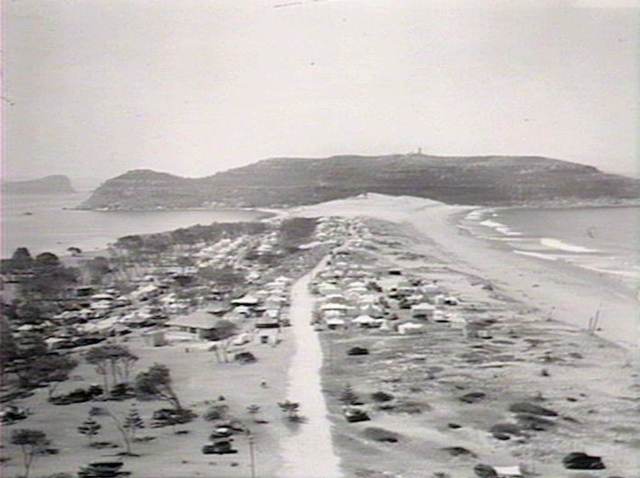
Above: Palm Beach, Government Printing Office 1 – 36503, No. d1_36503 Courtesy State Library of NSW, Date of Work; 12/1946
The men fished, swam, tightened tent ropes, and employed themselves in male fashion; the children-well it was "nice for the kids"; but the women toiled interminably, cooking food over open fires, stifled by smoke, harried by wind. They washed babies and baby clothes; minded children, shrilled at children, stood In long patient lines for essential services, and probably spent a great deal of time wondering why In the name of Christmas they had left their suburban dwellings with gas, electricity, and fences to keep the youngsters nicely corralled, for, that wilderness of discomfort, overmuch fresh air, sand, and wind without end, which, far from embracing the beauties of nature, provided about as much privacy as camping In Martin Place; and where all the personal bodily functions of one's, fellows are forced upon one in a manner no village of primitive natives would suffer for a moment.
SUCH a life is guaranteed to stamp from anyone with a millionth grain of individualism, all desire to lead a life communal. Strange figures loom up in doorways-your doorway. Or they stalk majestically out of the bushes, you might reasonably regard as your private property. You wait in Queues at the tap (for water), at the shop (for milk, bread, groceries), and at the showers. Australians whom I thought would never come at it have been brow-beaten by war into queue mindedness.' So much so that they even accept a holiday on the queue plan with equanimity.
But camping en masse sharpens your sense of humour-or else, without that God-given gift of being able to see the amusing, life is just too terribly tough. Walking into your neighbour's pile of fish scales with your bare feet is apt to send you Into a fit of fury; the man who (you feel) has deliberately blocked your means of exit with his two-ton truck and with whom you have already exchanged some unpleasant remarks, turns from being just a suburban carter in festive mood to a devil incarnate whom it would be pleasant to brain with the tomahawk. The fat woman some tents down, with the hairy legs, who insists upon wedging herself into a fiery-red sun-suit, becomes a personal affront. Worst of all you realise that the joke is on you, and that your desire to get away from it all for the Christmas break, has landed you in the same I company you have been keeping In the Bondi bus or Manly ferry for the other 51 weeks of the year. It is a shattering thought. There is no health in it.
“It’s the working man’s only chance of a holiday." said the outsize philosopher to whom I remarked that life In a lonely desert might be fun. "Thems that don't like it, done ‘atta come.”
True, brother, true. But I still have to have more proof than that, that the Australian spirit has shrunk as small it is accommodated from choice in a ten foot square of camping area, magnanimously allowed it by any local authority. Sandwiched between the interests who boost all habitable seaside land in Australia to ridiculous figures quite beyond the reach of the man who earns a modest living and supports' a family; and the minority-manoeuvred opinion of the so-called masses who regard any desire to be different as rank heresy, my philosopher was probably right In that the working man has little choice. But that the Australian on his day off or on his holiday can be happy, proves not so much that he is pleased with what is available as that he has a soul that can soar above his environment.
Ah Me—The Beauties Of Nature!. (1945, January 13). The Sydney Morning Herald (NSW : 1842 - 1954), p. 8. Retrieved fromhttp://nla.gov.au/nla.news-article27926248
The persistence in trying to keep campers temporary shows in this report:
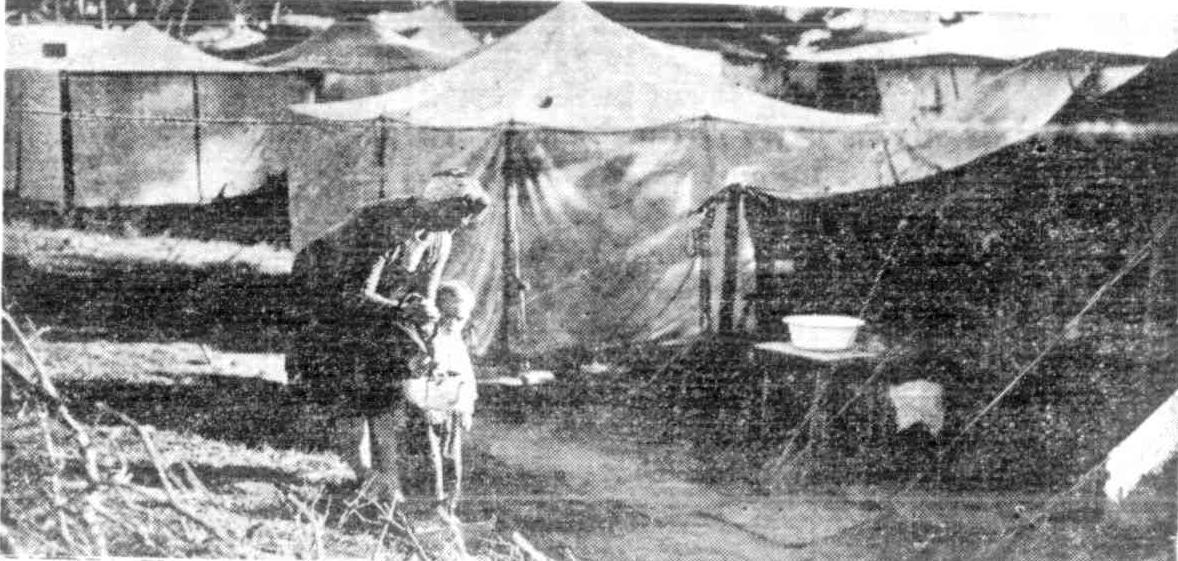
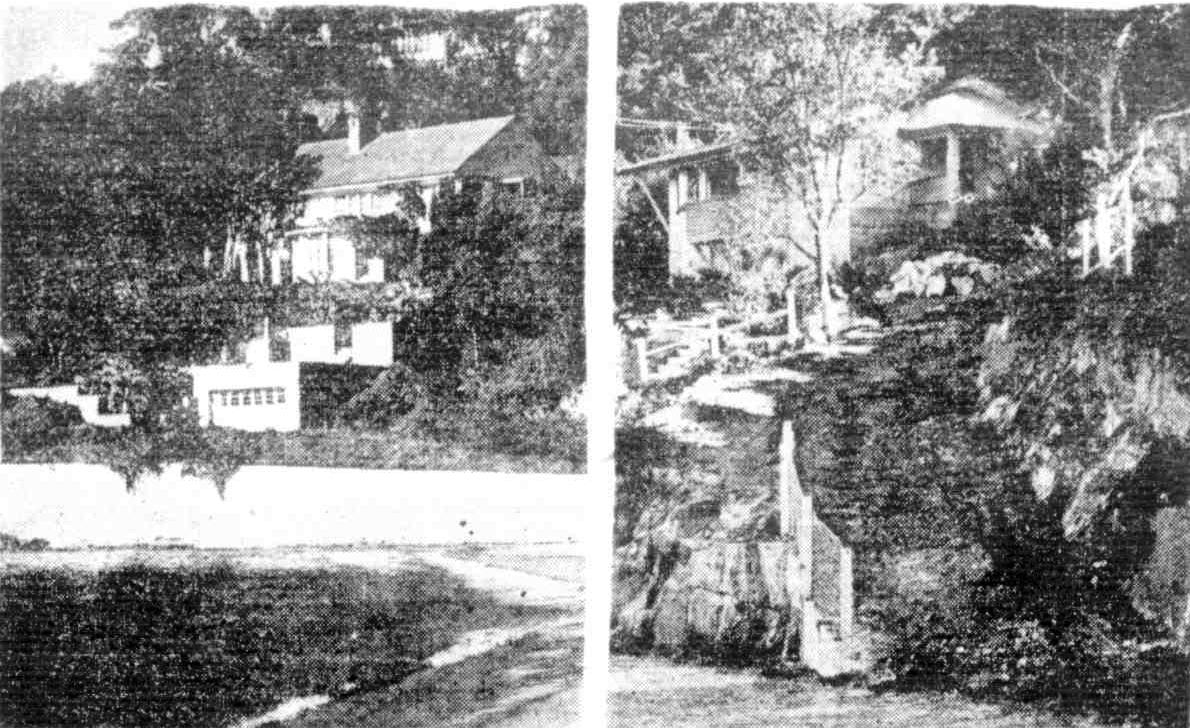
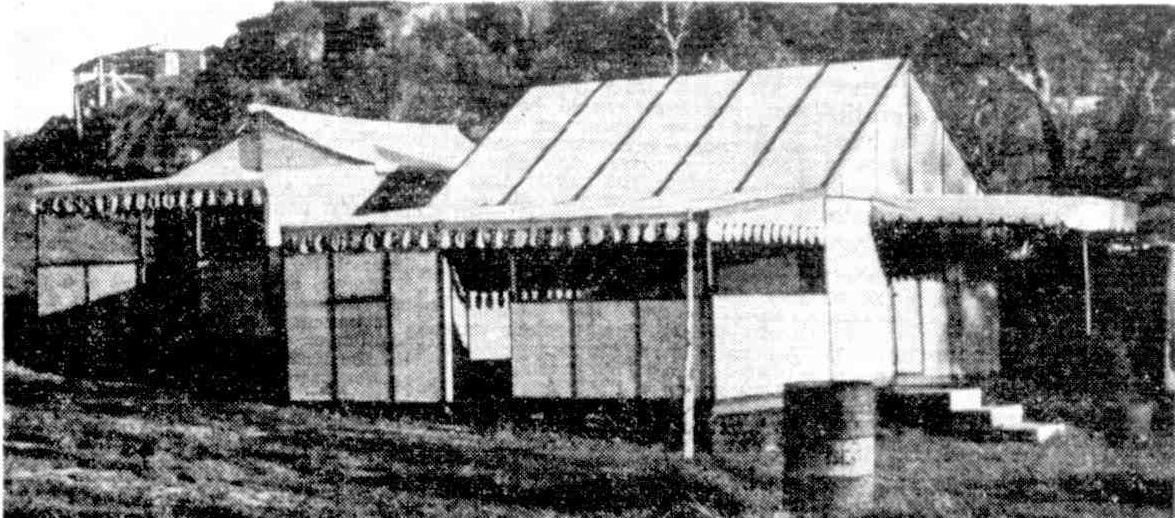
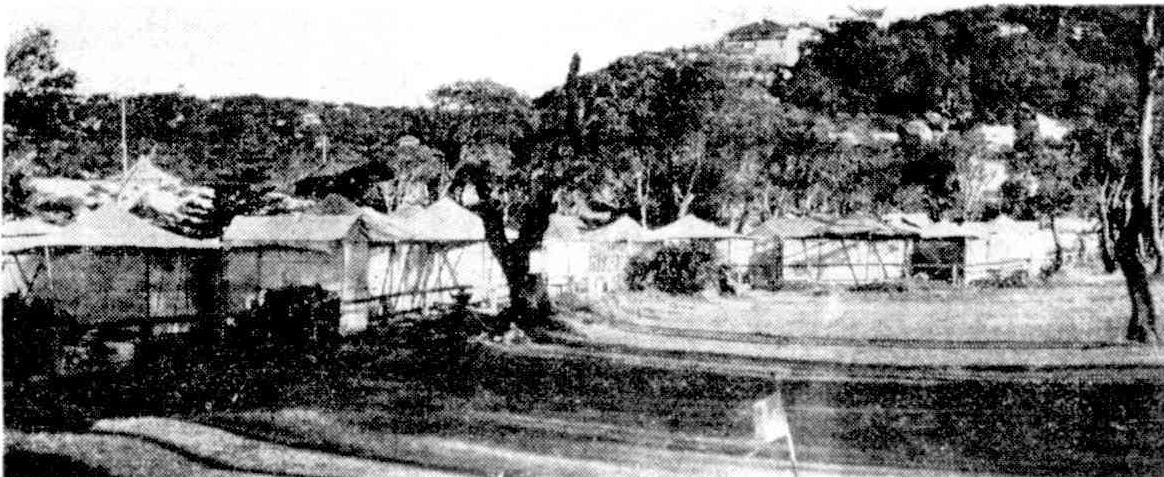
Palm Beach, where the fortunate rough it during the summer months, is without any beach. Apparently it's something to do with the winds moving the sand. The consternation among the locals at this development Is balanced somewhat by their fervent hope that it will knock the 'tripper' traffic on the head. Lister Ifould (ex R.A.A.F., D.S.O..D.F.C.), who has been a Palm Beach surfer for about 17 years, tells me that the sea encroached once before in the twenties. Then the waves lapped right across the road which runs along the foreshore. He thinks that when the north easterlies start again the sand on the beach will build up. Until that happens, however. Palm Beach will have to depend for its popularity on Its 'atmosphere, ''Atmosphere' at thirty guineas a week (which is the rent paid for the larger houses) is expensive. The surf seemed to be sprinkled fairly freely with the Royal Navy. I can only assume that they have more skill when manouvring on top of the water than when actually submerged in it. Admiral Sir Philip Vian. Whose war record proved that he could 'take it' as well as dish it out, took 20 minutes' consistent dumping in bulldog style. Admiral Sir Bruce Fraser, another learner, was enthusiastic, if unskilful. His navigation was faulty, and twice he had to be ordered out of dangerous waters by the beach patrol. Now that Admiral Fraser has a house at Palm Beach (the Coles' above the swimming pool) there is considerable coming and going of naval 'brass.' The other day I met Rear-Admiral Nigel Oliver, on whose ship, H.M.S. Hilary, I had the doubtful pleasure of crossing to Normandy on D-Day. DIARY OF SYDNEY. (1945, November 22). Townsville Daily Bulletin (Qld. : 1885 - 1954), p. 5. Retrieved from http://nla.gov.au/nla.news-article62872198
Thousands Under Canvas More than 10,000 persons, it was officially estimated, spent the Christmas holidays under canvas on the Warringah Council's camping areas. The biggest camps were at Lake Park, Narrabeen, and Governor Phillip Park, Palm Beach, at each of which there were about 700 tents. THOUSANDS LEAVE SYDNEY. (1945, December 27). The Sydney Morning Herald (NSW : 1842 - 1954), p. 1. Retrieved from http://nla.gov.au/nla.news-article17964638
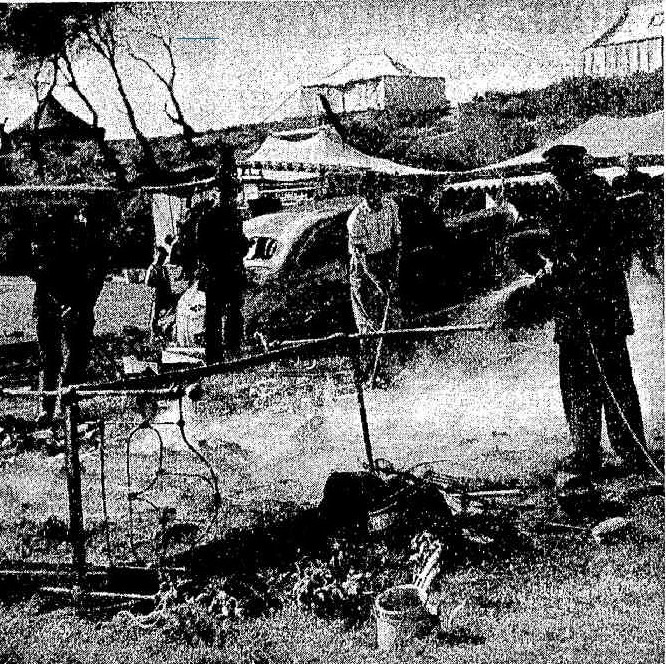
FOUR CAMPS DESTROYED AT PALM BEACH - Fire destroyed four camps and a large motor car at Palm Beach yesterday. It is believed to have been caused by a spark from an open fireplace. The car was owned by Mrs. A. Sunderland, Bondi Road, Bellevue Hill, who narrowly escaped being trapped in her tent with her six-month-old baby, Sandra. She lost all her clothing as well as the furniture and fittings.FOUR CAMPS DESTROYED AT PALM BEACH. (1946, July 25).The Sydney Morning Herald (NSW : 1842 - 1954), p. 3. Retrieved from http://nla.gov.au/nla.news-article29766949
Another kind of camp at Palm Beach:
An electric timing device belt is the latest invention of Palm Beach surfer, Forbes Carlile, who loves to toy around with gadgets to improve surf and baths swimmers.
The timing device, run by a motor with a clock attached, consists of a revolving belt, with a flag attached, running the full length of the baths. The clock is set, and a swimmer keeps pace with the flag according to his own timing. The clock can be set for beginners or champions. When the swimmer finds he can beat the flag he sets the clock to race faster. Carlile also uses a slow motion camera to detect faults in club members. He has taken hundreds of pictures and shown them at Palm Beach club. At Christmas, Forbes will hold a six weeks' holiday camp at Palm Beach. Many prominent surfers and swimmers will attend. Surf NEWSREEL (1946, October 22). The Sun (Sydney, NSW : 1910 - 1954), p. 13 (LATE FINAL EXTRA). Retrieved from http://nla.gov.au/nla.news-article229543143
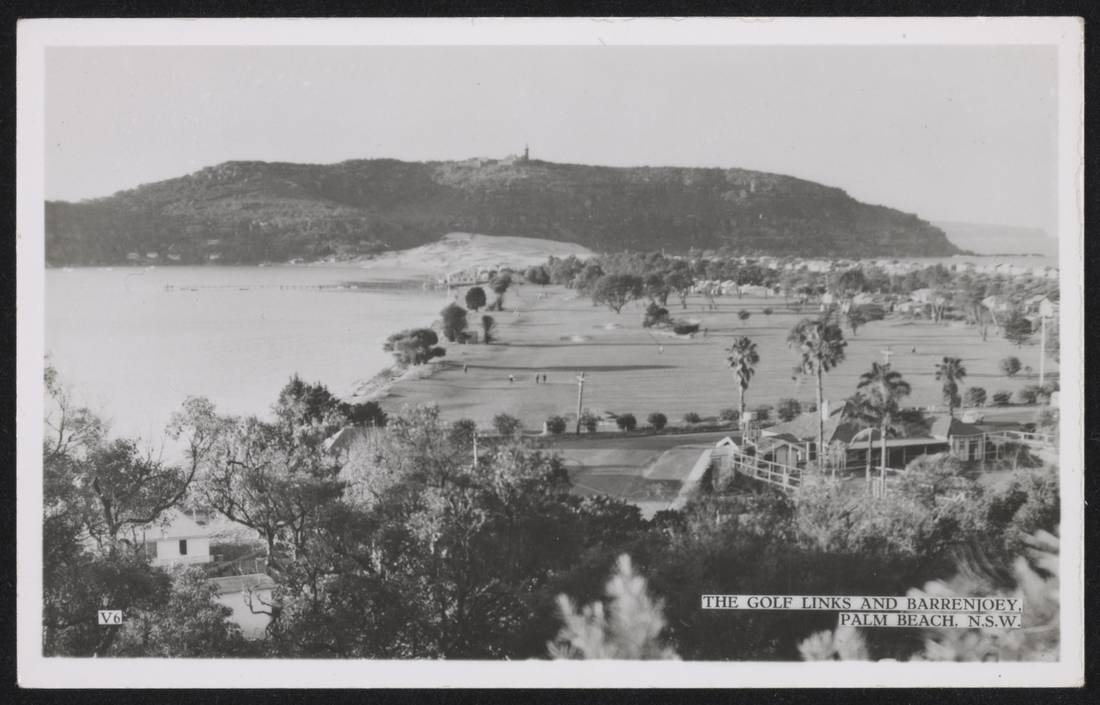
Palm Beach Golf Course circa 1947, showing tents of campers in background and Barrenjoey Boathouse and trees on golf link greens. Courtesy National Museum of Australia, from Josef Lebovic Gallery collection no. 1. And below one prior to the Barrenjoey Boatshed being built and tarred roads from the same collection:
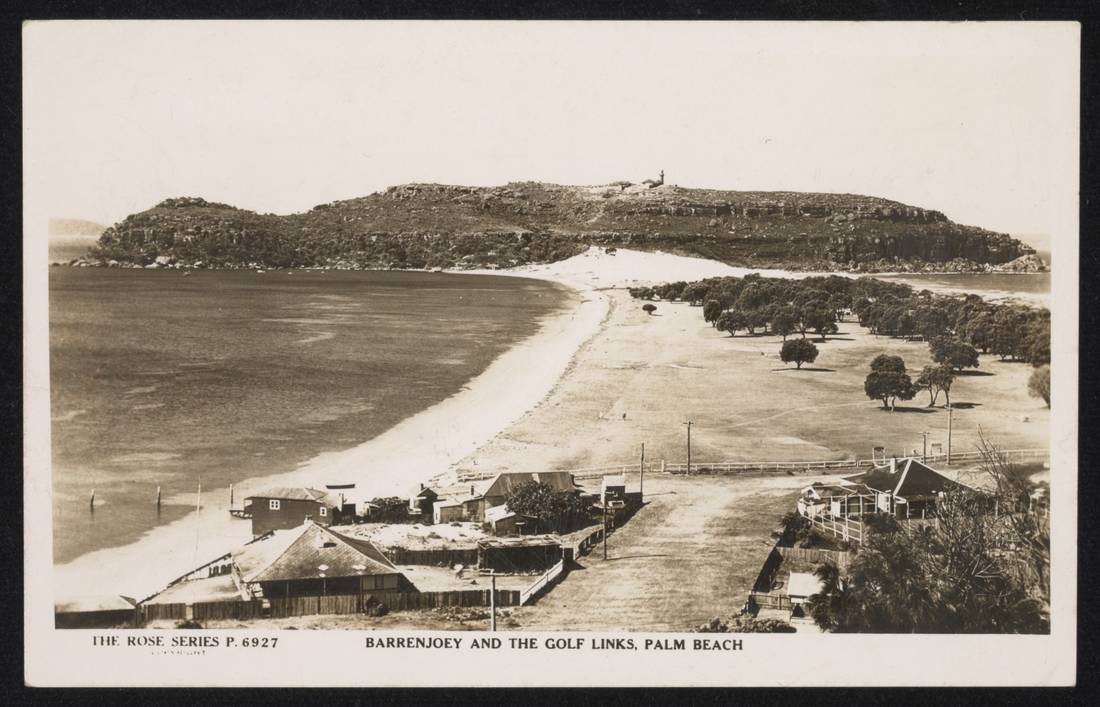
Caravan Days
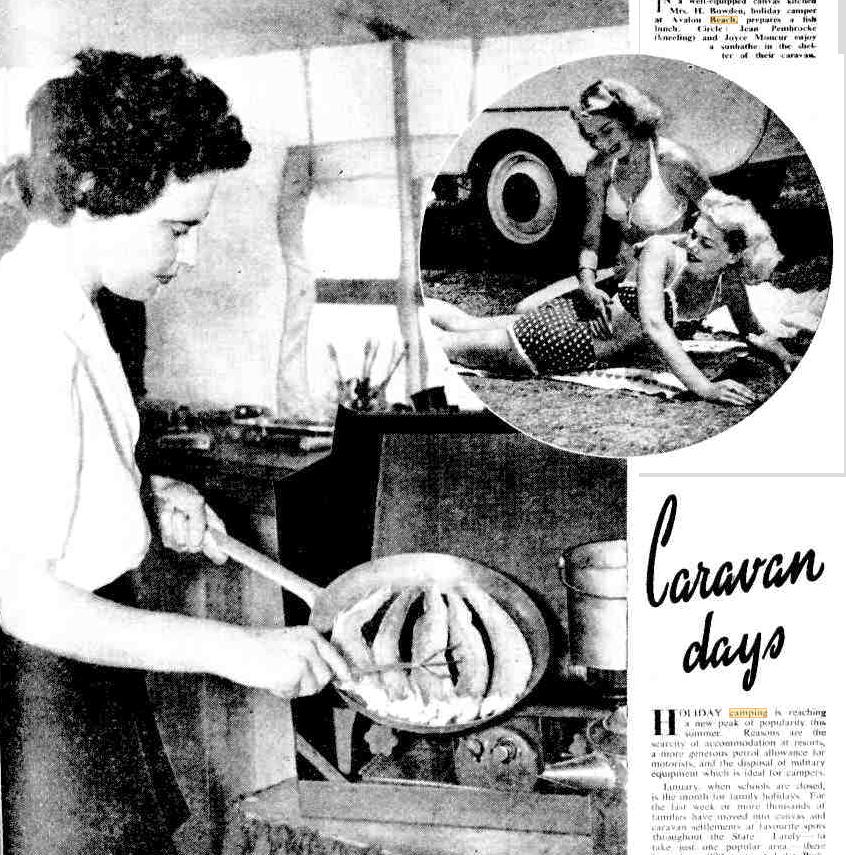
IN a well-equipped canvas kitchen Mrs. H. Bowden, holiday camper at Avalon Beach, prepares a fish lunch. Circle : Jean Pembrocke (kneeling) and Joyce Moncur enjoy a sunbathe in the shelter of their caravan.
HOLIDAY camping is reaching a new peak of popularity this summer. Reasons are the scarcity of accommodation at resorts, a more generous petrol allowance for motorists, and the disposal of military equipment which is ideal for campers.
January, when schools are closed, is the month for family holidays. For the last week or more thousands of families, have moved into canvas and . caravan settlements at favourite spots throughout the State. Lately--to take just one popular area - there have been 900 tents at Lake Park, Narrabeen Lakes, 500 at Philip Park, Palm Beach, and 150 at Avalon Beach.
Camp life, whether in.the luxury of a mobile dwelling or under canvas, is a test of adaptability. But most Australian families pass the test with ease and zest. Having once tasted the free and easy independence, the fun and the simple economy Of camping, they seldom return to conventional ways of holiday making. (More pictures and story on page 12.) Caravan days (1947, January 7). The Sydney Morning Herald (NSW : 1842 - 1954), p. 1 (The Sydney Morning Herald Magazine.). Retrieved from http://nla.gov.au/nla.news-article27904020
The presence of lifesavers at north Palm Beach, many of whom stayed within the camp, didn't stop tragedies from occurring - with thousands of people camping in the reserve or visiting, many more may have been lost:
Woman Drowned At Palm Beach
SYDNEY.-Hazel Jones, 32, single, of Hunter's Hill, was drowned at Palm Beach Monday night after her male companion had made a courageous effort to save both her and another woman. The man got one woman safely ashore, but when he returned to help Miss Jones he was unable to find her in the pitch darkness. Miss Jones' body has not yet been recovered.
Miss Jones, who was staying with friends at the Governor Phillip camping park, accompanied William McKay and Mrs. Dorothy Sampson to the north end of Palm Beach for a swim. Finding the baths empty they decided to try the surf, but stepped into a channel and were quickly swept 50 yards out.
After supporting both women for several minutes McKay, also got into difficulties, but managed to got Mrs. Sampson to the rocks, while Miss Jones trod water. He then went back for Miss Jones, but a five minutes' search failed to find her and he then swam to the beach to summon aid. Woman Drowned At Palm Beach (1947, February 19). Barrier Miner (Broken Hill, NSW : 1888 - 1954), p. 4. Retrieved from http://nla.gov.au/nla.news-article48490241
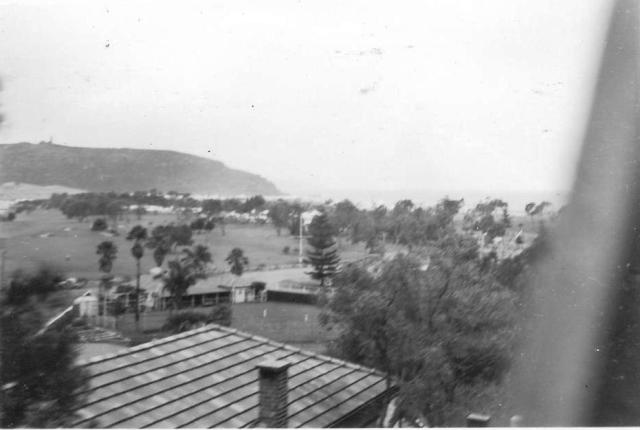
Palm Beach (N.S.W.) – 1948 (Motor Camp: 260 sites 30 x 30). Professional men maintain camp year round. Note golf course, tennis courts, beach surf, fishing and boating. Unsatisfactory campers are evicted under local Govt. (Company) Reserves Act. Photographer unknown. Part of the Archives ACT collection.
There was also a problem with livestock and goats:
Palm Beach Guide
The Sheep And The Goats
Palm Beach, according to the social columnists, is where Sydney's smart set read each other's private lives in the social columns and wear bathing suits to avoid photographers.
But there are three Palm Beaches: south Palm Beach of the columnists' darlings; north Palm Beach of the campers on the peninsula, whose tents line the little golf course; and the Palm Beach of the day tourists, who romp everywhere during the week-end. Rubbing: along fairly well together, they rub a lot of Palm Beach glamor off in the process. Palm Beach aristocracy huddle quite definitely into groups at the week-end among the surrounding trippers. To smile for a photographer is one thing: but to smile at a tripper. . . .! And with the cads are In bathing suits, it's so hard to tell the difference.
Twice a No-Dogs-on-the-Beach sign has been put up: twice it has been torn down.
"Time was," said an old resident in knee-length shorts and a topee, "when there was room on this beach for all of us and our dogs. Now they kick my dog off the beach and let on hordes of trippers. They call that enforcing the regulations!"
But if Palm Beach life centres round the surf club; a modest little two-story building to club in;' another modest little two-story building to entertain in. All University Men, No matter what their age, they've got to serve a year's cadetship and live in club so that other members can be sure whether' they will be suitable.
These conditions make it a bit difficult for campers at the north end of the beach to join the surf club. So the more-or-less regulars have formed their own surf club, a wooden shed well up on the beach, almost finished. They ran Housie-Housie games to finance their surf boat, reels, and so on.
''They do all the drills and take out the boat and lines just like any other surf club," said Mr. Michael Barker, camp superintendent and ex-naval man.
"I don't think they belong to any association, but they've got their bronzes and all that."
"They don't hanker to join the club down the beach?" Smith's asked.
Mr. Barker thought for a moment. "It's too far away," he said finally. "Besides, they feel they should look after the safety of their, own women and children."
The Camp runs to 200 odd tents, housing as many as 2000 people. Tent names: "Welivere," "Kum Anava Chat," "Thistledo Us.'' form a pleasing complement to the more sedate "Aurora's," "Alcira's," "Kendall's," "Kendall Lodge's," and "Mandalay's" on the hill.
On the beach, down from the brick dressing sheds, is the only Beach Bazaar in the world that has large, modernistic oil paintings for sale. And hand-blocked cottons for sarongs. And lipsticks. Kept by a blonde gentleman in floral trunks.
"Bit crowded at week-ends for this kind of merchandise " Smith's said. "Place is getting a bit commercialised," he said, "but all places do. I've been coming here since the year dot, but they haven't mucked up the beach with promenades and all that. Yet."
"Classes here?" said a young man on the rise overlooking the beach. He was In Trade at Palm Beach ; a week-ender at his home at Coogee,
"I'll say there's classes here. Should see 'em at weekends."
"But you see some lovely girls here," Smith's said.
He looked unmoved at the young men and maidens radiating from beach umbrellas.
"Not my type," he said meditatively. "I think they're a lot of. good actors. I'll say that for them. Coogee and Coogee girls will do me." Palm Beach Guide (1948, January 3). Smith's Weekly (Sydney, NSW : 1919 - 1950), p. 9. Retrieved from http://nla.gov.au/nla.news-article234625645
Warringah Shire Campaign - Shack And Tent Dwellers Lose Their Permits - Check For Rackets
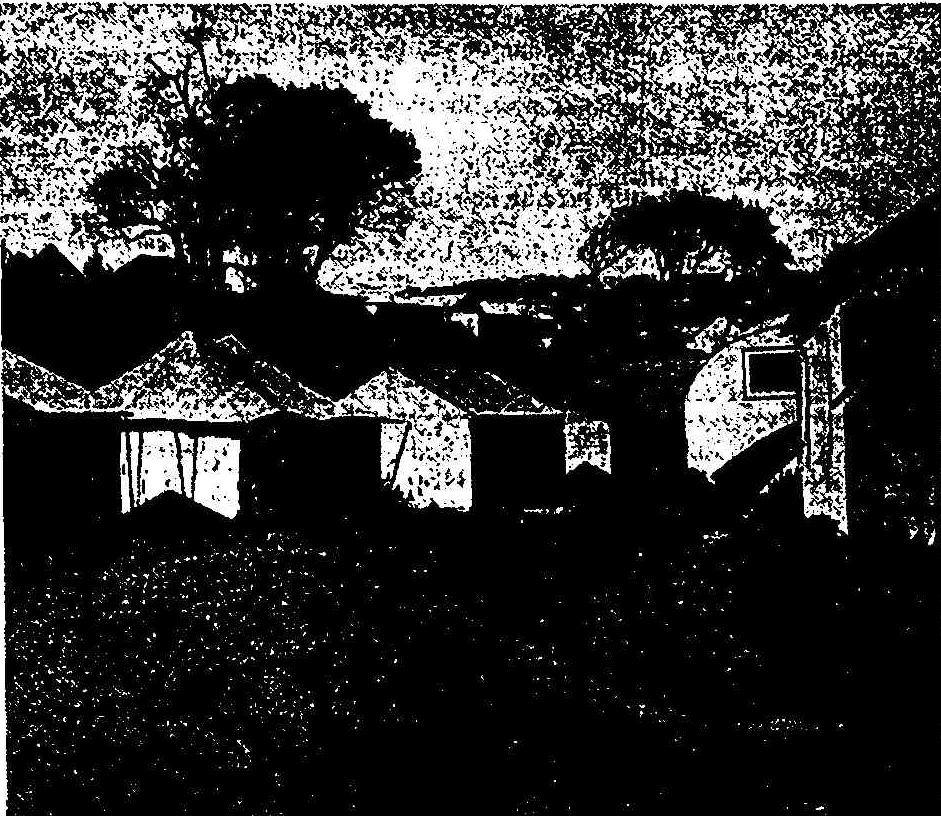
Temporary camps and huts at Palm Beach.
More than 1,000 families living in garages, tents, sheds and shacks between Manly Vale and Palm Beach are affected by a recent decision of Warringah Shire Council to clean up sub-standard homes. Last week the council started to send out hundreds of notices, informing occupants of "temporary dwellings" that permission to occupy the dwellings had been revoked by the council.
The council informed the people that they would have to comply with certain provisions to get a new order to remain in occupancy.
The president of the shire, Cr. J. L. Fisher, said the council had taken this action to:
* Clean up a large number of sub-standard homes; * Stop racketeers from fleecing homeless people; * Improve health standards in the shire.
"We are not refusing a home to the genuine homeless, but we are making it impossible for the racketeer and the speculator to deal in temporary dwellings," he said.
Cr. Fisher said the racketeers had exploited homeless people by erecting a garage or temporary dwelling on a block of land, putting a few sticks of furniture in it, and selling it as a "home" for big money. There were about 1,100 temporary dwellings in the shire.
Three Conditions
The council in the past had waived building regulations to allow homeless people to occupy temporary dwellings while they built a house. Cr. Fisher said. In hundreds of instances the owners of such places had made no attempt to erect a house.
Now permits to occupy a temporary dwelling would be issued only provided:
THE BUILDING is to be part of a permanent structure approved by council;
THE APPLICANT makes a statutory declaration that the building would be used as a residential building;.
A CAVEAT is entered on the deeds of the property showing it to be a temporary dwelling-not transferable by law.
Cr. Fisher said people in temporary dwellings who intended to build permanent homes on their land would be given reasonable time to do so.
PALM BEACH TENTS
Unless council officers were satisfied that these people were making attempts to erect permanent homes, action would be taken. He said the council at a later meeting would determine its attitude to people who were living permanently in canvas homes on council camping areas at Palm Beach, Lake Park, and other places.
These people paid a camp fee of 15/ a week to the council. Comments from occupants of temporary dwellings in the area last week included these:
Mr. Peter Minigle, Palm Beach camping area: "I am a pensioned stonemason, and could not afford to live any-where else. My wife and I are comfortable here, and much healthier than when we were living at Paddington."
Mrs. M. Petronljevic, PAYING IT OFF Mrs. M. Petronljevfc, Careel Head Road, North Avalon: "We don't like it, but we have to live in a garage until we can build a home. My husband and I had nowhere else to live when we married, and paid £ 1,000 for the land and dwelling. We are still paying it off before we can build."
A woman at North Avalon said she was paying £2 a week rent for a 24ft by 12ft dwelling erected by a man who had since built a home on another block for himself. A man at Mona Vale said he had built the first two rooms of his home, but was held up for finance to complete the dwelling.
Another Housing Problem - Injustice Seen To Landlords
The president of the N.S.W. Real Estate Institute, Mr. Harry Amadio, said proposed amendments to the Landlord and Tenant Act ignored the most important question for the home owner--when could he gain possession of his own home. Nor did they provide any relief to property owners whose charges were pegged at 1939 levels.
Major provisions of amendments, approved by the State Cabinet but yet to be passed by Parliament, are that Federal Land Tax may be taken into consideration in rents for some large properties, and that premises let for a continuous period of more than eight weeks to be disqualified as "holiday premises."
The amendments fail by far to remedy injustices and anomalies of the Act," Mr. Amadio said. The amendments do nothing to encourage an increase in urgently required accommodation, either by way of new buildings for letting purposes. or subdivision of large houses to provide home units.
"Owners will not construct new buildings nor will home owners subdivide their homes, knowing that they will be compelled to take rentals based on 1939 values and, to make matters worse, will have no control over their tenants."
Mr. Amadio said that if a person subdivided his home and accepted a tenant he could not be sure of getting the tenant out again, even if he turned out to be a black-marketeer, S.P. bookmaker, or habitual drunkard.
COSTLY COURTS
The owner would have to go through the long procedure of the Courts and he would be lucky if it cost him less than £50. Even then he would be quite unassured of success.
Mr. Amadio said rents were pegged on 1939 levels, but it was safe to assume that most owners of properties were receiving a smaller net return today than in 1939. Warringah Shire Campaign Shack And Tent Dwellers Lose Their Permits (1952, May 25). The Sunday Herald (Sydney, NSW : 1949 - 1953), , p. 5. Retrieved from http://nla.gov.au/nla.news-article28671967

Palm Beach 1946. From NSW Government Printer series: Pittwater, courtesy NSW State Records and Archives. Item: FL3733992
Increase In Fees Angers Palm Beach Campers
Campers at Phillip Park, Palm Beach, will meet this afternoon to protest against a recent decision by Warringah Council to increase their camp fees from 15/ to £1 a week. Alderman A. W. Thompson, of the City Council, who has a week-end camp at Phillip Park, said last night campers feared that the increase was part of a plan to force them off the reserve. The fees had been increased in stages from 2/61 to 15/.
"At the last Warringah council meeting one alderman suggested that the fees be in-creased by 5/ every 21 days until they are high enough to drive campers out," Aid. Thompson said. '
"Phillip Park does not belong to Warringah Shire, but to the Lands Department.
MINISTER'S WARNING
"On a previous occasion when the council tried to oust campers, Mr. Tully, who was then Minister for Lands, said that if the campers were not left alone the department would take control of the area.
"At the meeting we will appoint a camp executive, and if Warringah Shire does not give us a fair go we will approach the Lands Mini-ster,' Mr. Hawkins, and suggest that a committee be appointed to accept responsibility for the area."
Ald. Thompson said there were about 250 camps on the reserve, with a big influx at holidays. Last year the camp had shown a profit of about £12,500 to the council.
COUNCIL'S VIEW
The president of the Warringah Shire Council, Councillor J. L. Fisher, said the council was not trying to force the campers from the area. "We are administering the areas as trustees for the Lands Department, and have to bear the full cost of such administration," he said.
Fees had been increased to maintain garbage and other services. The council had in hand plans for improving camp facilities, with showers, laundry and sanitary services, he added. Increase In Fees Angers Palm Beach Campers (1952, August 17). The Sunday Herald (Sydney, NSW : 1949 - 1953), p. 5. Retrieved from http://nla.gov.au/nla.news-article18509525
Palm Beach lady Marie Byles weighs in:
Palm Beach Camp
Sir,—It is gratifying to read that there at last seems a possibility that Warringah Shire Council will put an end to the permanent camps on Phillip Park.
Permanent camps on a public park have been a scandal for many years. They are instances of the filching of public lands by private individuals.
M. B. BYLES.
Eastwood.
Palm Beach Camp (1952, August 25). The Sydney Morning Herald (NSW : 1842 - 1954), p. 2. Retrieved from http://nla.gov.au/nla.news-article18278690
The camping area wasn't closed then, another fire in June 1952, and the continued presence of permanent campers brought renewed discussions regarding how the area, and those in it, should be looked after:
Fire Destroys 11 Camps At Beach
A fire at Governor Phillip Park, Palm Beach, yesterday destroyed 11 camps, a late-model car and a utility truck. Two families who had set up permanent homes at the camp lost them in the fire. Police .and firemen estimated the damage at more than £10.000.
Warringah Shire Council controls the camping area which is used mostly by week-end holidaymakers.
The fire broke out when a spirit stove exploded in Mrs. E. Crew's camp. A breeze swept the flames to other camps within minutes. Firemen, police and volunteers pulled down two camps and used them as fire breaks.
The camp manager, Mr. Jack Lofthouse, received burns on the face and hands while helping to fight the fire.
Mr. Douglas Canty, acting captain of the Avalon Volunteer Fire Brigade, was over-come by smoke while removing articles from one of the camps. Ambulance officers treated both men.
FAMILY'S PLIGHT
Mr. Don Maloney, 29, his wife Joyce and their children, Robin, 7, Helen, 4, and Peter, 2, lost all their belongings and are now homeless. Mr. Maloney, who had lived in the camp for four years, estimated his loss at £900. He had no insurance.
He said: "We were sitting down to lunch about 12.50 when we heard a series of explosions. "I ran outside and saw flames shooting towards us.
"I went back and shepherded my family to safety. "We just stood' helplessly by and watched the flames burn everything we owned.
"Had we stayed in the camp for another minute we would have been engulfed, "I have had my name down for a Housing Commission place for eight years. "Surely they, can help us now."
The other permanent campers made homeless are Mr. and Mrs. W. Hill, an elderly couple, whose be-longings were insured for £500. They will stay with relatives until they find other accommodation.
Mrs. Crew said: "We were cooking a roast dinner when the stove went out. "I was trying to light it when it blew up. "The flames got too much for us and we had to run for our lives. "I lost about £300 in cash. "It represented takings from my business at Earlwood. "I also lost diamond rings valued at about £400. "Nothing was insured."
Mrs. Crew said that she and three friends used her camp at week-ends.
OTHER LOSERS
The owners of other week-end .camps- which were destroyed include Mr. and Mrs. D. Hardacre, Mr. and Mrs. T. Oliver, Mr. L. G. Thomas, Mr. and Mrs. H. Jarrold. Mr. and Mrs. L. Coppen, Mr. and Mrs. G. Brown, and Mr. and Mrs. Arthur Brown.
Mr. M. McGinnes, owner of the burnt truck, said it was insured. He said that the car, owned by a friend of Mrs. Crew, was also insured. Brigades from Avalon, Manly and Narrabeen, under District Officer S. Bennett, attended the fire. Constable J. Gearon, of Mona Vale, is in charge of police inquiries.
(Picture, page 3)
FAMILY HOMELESS AFTER CAMP BLAZE
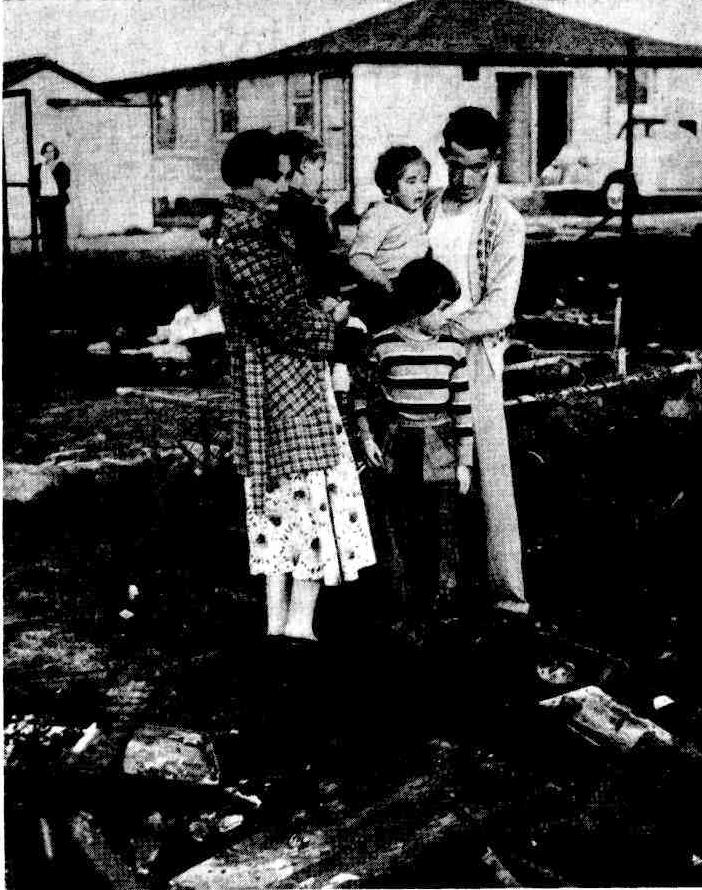
Mr. and Mrs. Donald Maloney and their children looking at the remains of their Palm Beach camp home which was destroyed by fire yesterday afternoon. They lost all their possessions in the fire. Fire Destroys 11 Camps At Beach (1954, June 21). The Sydney Morning Herald (NSW : 1842 - 1954), p. 1. Retrieved from http://nla.gov.au/nla.news-article18437565
Overhaul Of Camp At Palm Beach
The Warringah Shire Council last night adopted a presidential minute foreshadowing an over-haul of camping conditions at Governor Phillip Park, Palm Beach, which was swept by fire on Sunday. Eleven camps, a late model car and a utility truck were destroyed at the reserve on Sunday when a spirit stove exploded in one of the camps and a breeze swept flames to engulf others.
Warringah councillors last night instructed the Shire engineer to prepare a new lay-out for the camp to make it more attractive and safer.
The minute submitted by the shire president. Councillor J. Fisher, called for: (1) consideration of the number of tents to be allowed in the reserve area; (2) reconsideration of the materials which could be used in the construction of holiday camps; (3) the location of the camps within the reserve; (4) the availability of water and fire-fighting equipment within the reserve.
REPLANNING
Councillor Fisher said that Sunday's fire at the reserve highlighted the necessity for its replanning. The deputy president of the council, Councillor L. McKay, said the Palm Beach camp was very largely used by persons in comfortable circumstances who resided in the metropolitan area and used the camp for week-ends and holidays.
He said there were about 350 camps on the Governor Phillip Park reserve, and of these about 12 per cent, were used as permanent homes. The council charged a weekly rental of 15/ for each camp site.
Camps were in some cases timber-framed and covered with canvas or some other material. In some instances they were no more than four or five feet apart and thus constituted a definite fire hazard.
Councillor McKay said the Minister for Local Government, Mr. J. B. Renshaw, should take steps to provide that all reserves throughout the State were kept free of permanent dwellers.
Palm Beach and other beauty spots should be specifically kept for people who were legitimately on holiday, he said.
"So long as councils are permitted to charge for holiday sites they will take no action to see that permanent and semi-permanent dwellers are kept off reserves," he added. Overhaul Of Camp At Palm Beach (1954, June 22). The Sydney Morning Herald (NSW : 1842 - 1954), p. 8. Retrieved from http://nla.gov.au/nla.news-article18426355
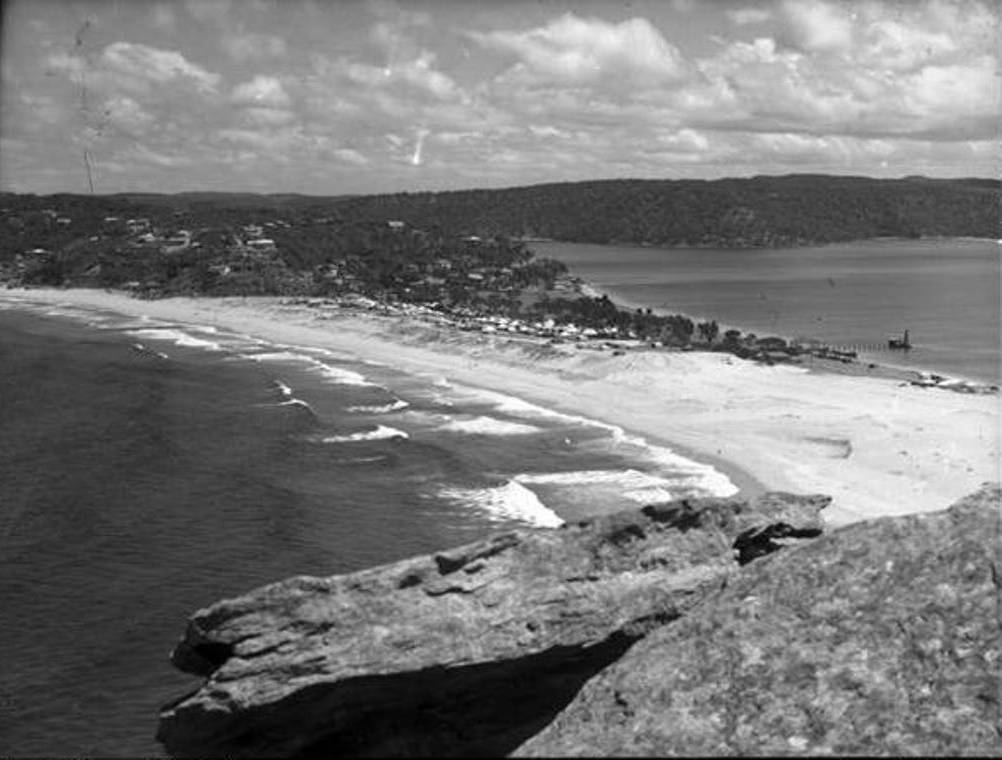
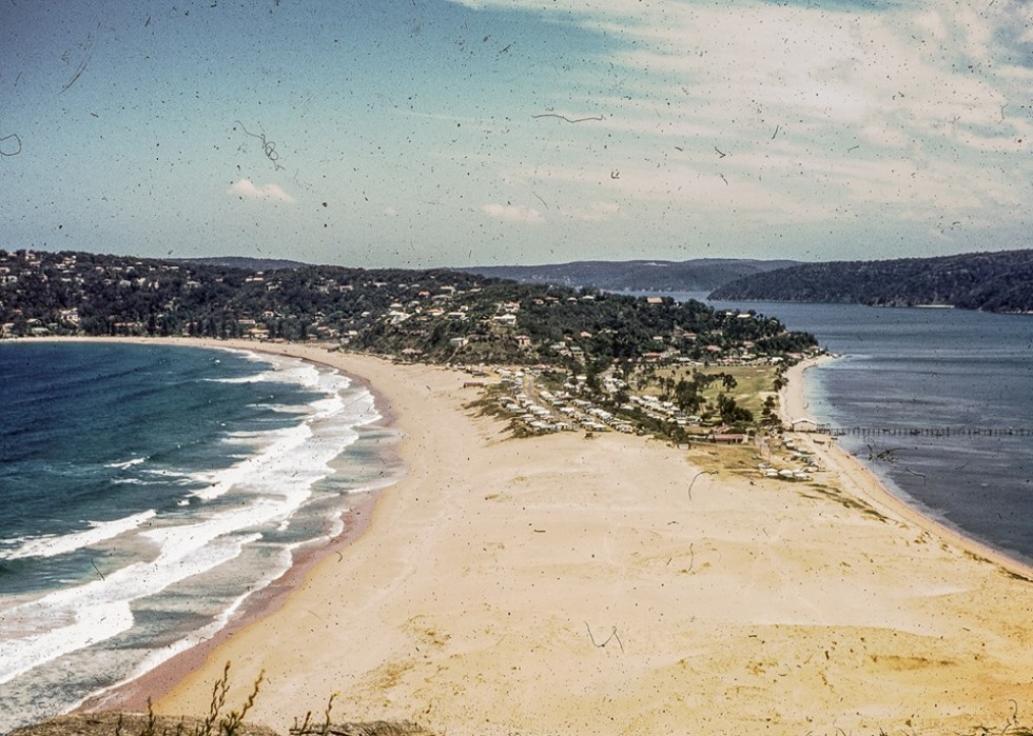
Palm Beach camping ground, circa 1955 - photo courtesy Dave Whiteman - taken from a family slide
